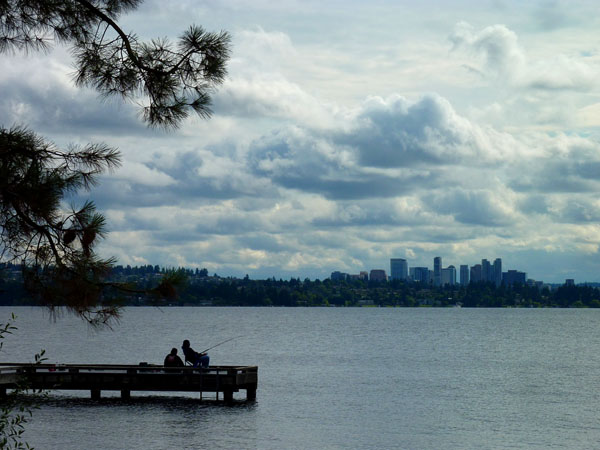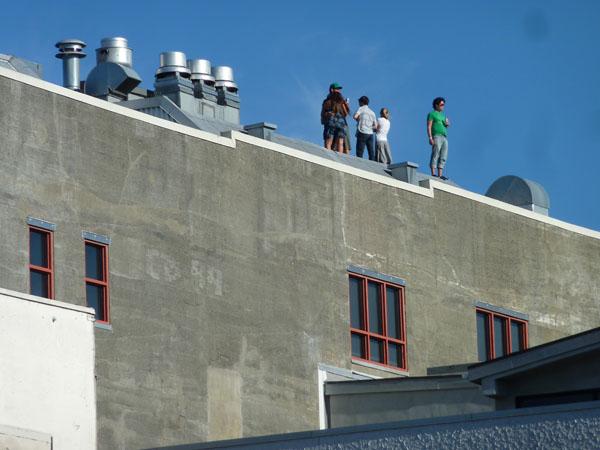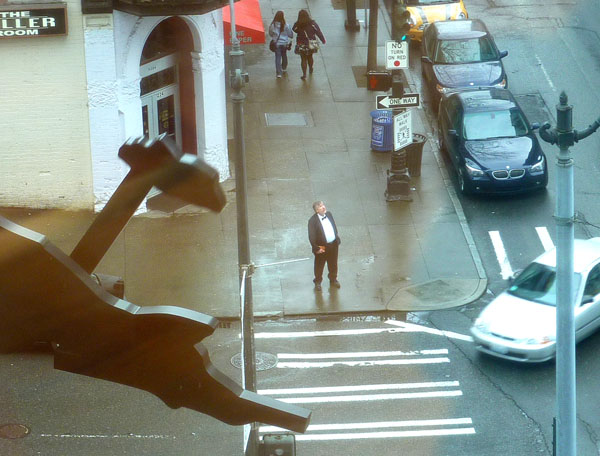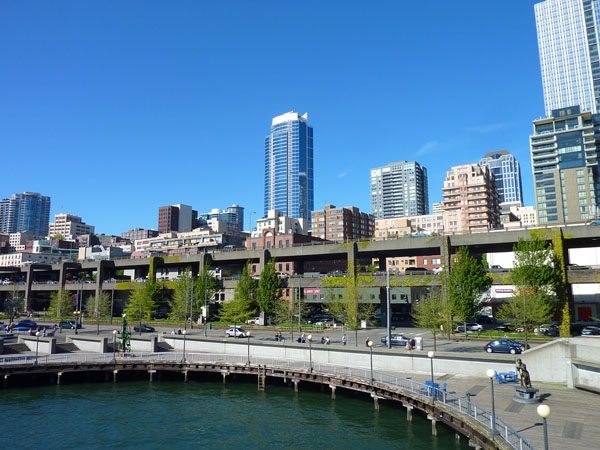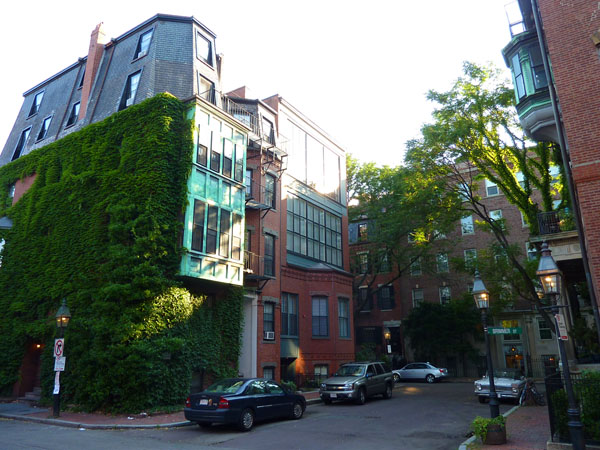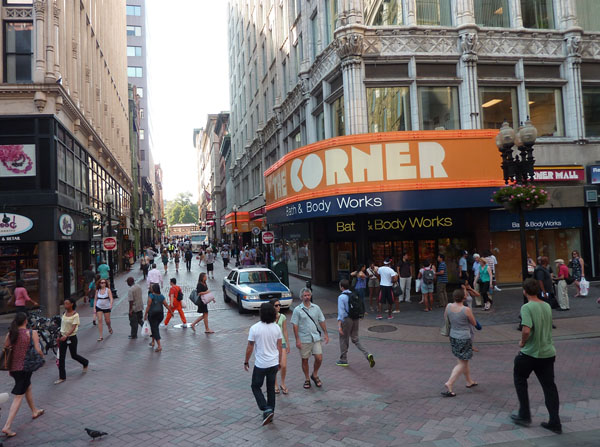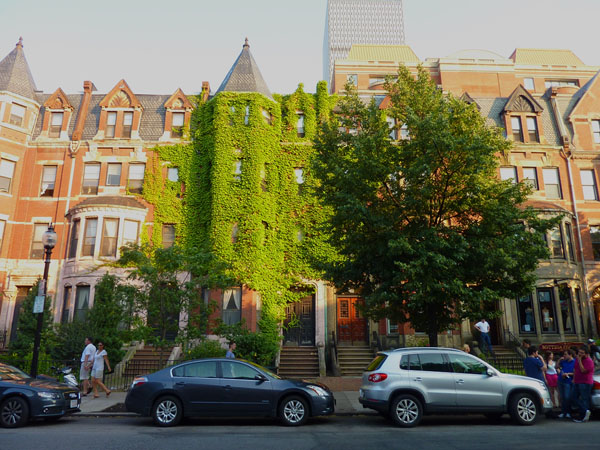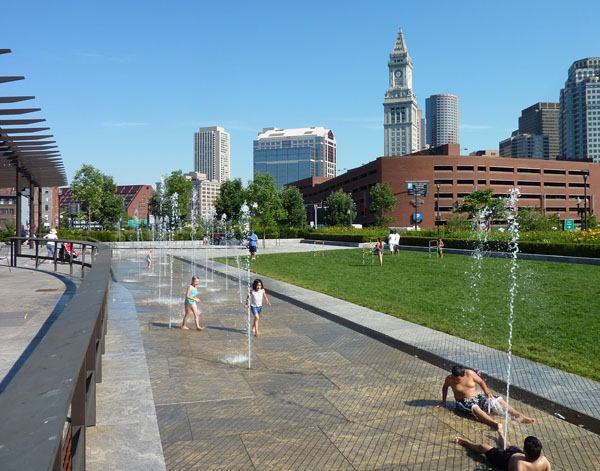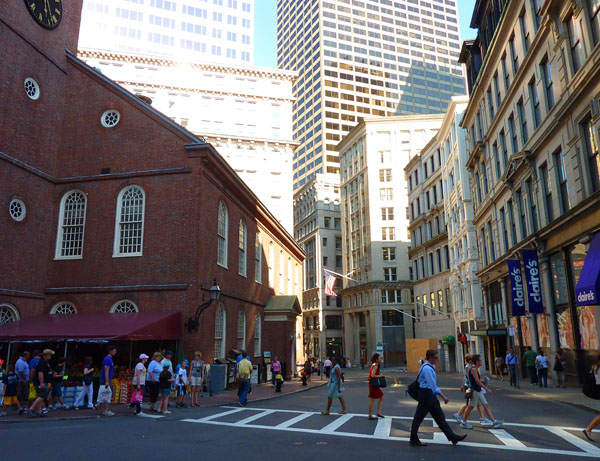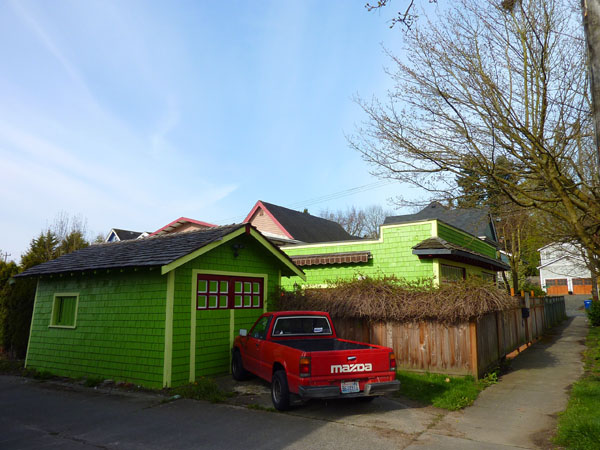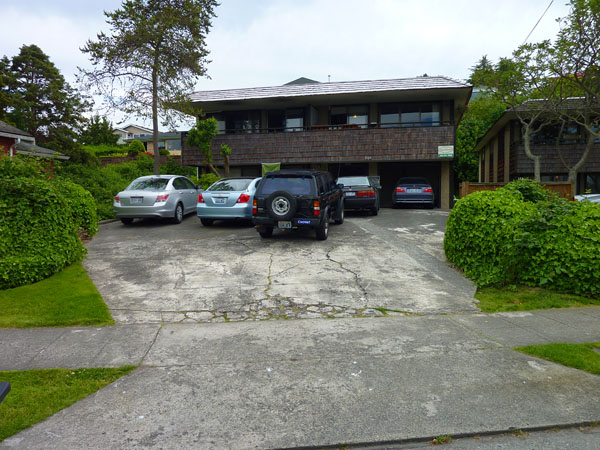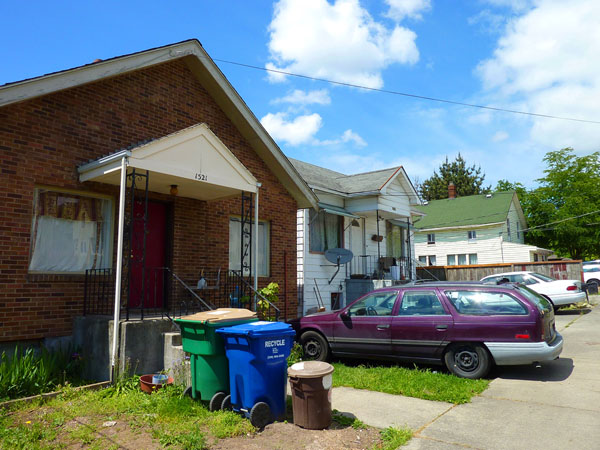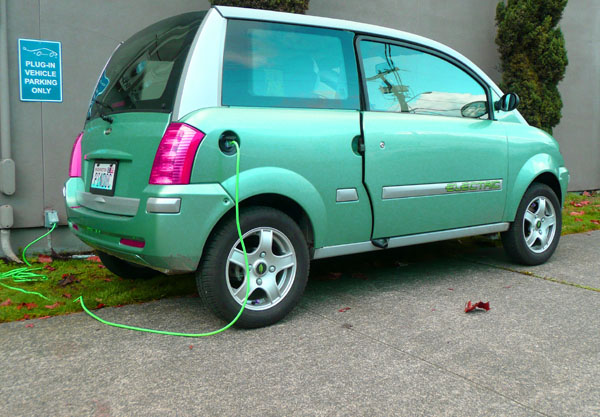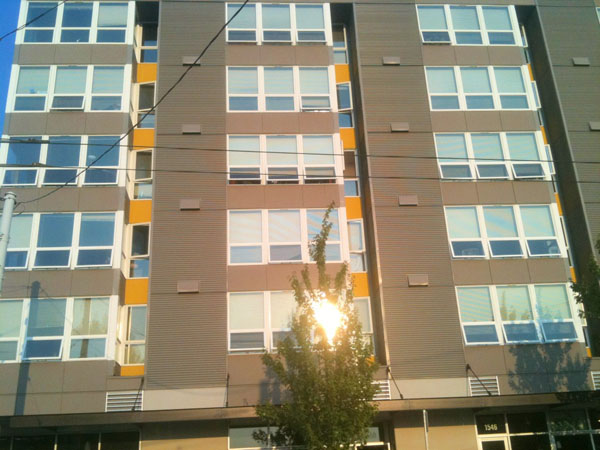
The assignment is to offer a ‘solution’ in 400 words or so. But my solution takes one word: density.
But I know that’s not good enough, so I’ll try to explain how I think more people living closer together can “heal the planet.†I will reprise my Urbanist Creed.
City life — lots of people living close together — is healthier, creates less damage to our air and water, is a more efficient use of land and energy, and fosters social cohesion and community.
The division between public and private realms is conceptual not physical—that is, we can live close together and still have privacy. We can build cities that allow every resident or visitor to move between the public and private realms at will, affordably, and with ease. Privacy and choice are important and cities can create more rather than fewer choices.
Aggregating the way we meet our basic needs — eating, drinking, housing ourselves, clothing ourselves, and entertaining each other — makes common sense, is more efficient than land use policies that separate use, and will build stronger connections between people of every race, class, sex, and orientation.
Living close together and meeting our needs close to home, makes getting around easier. By bringing the things we want and need closer to where we live we ensure less time traveling and more time living. And such a living arrangement creates positive interdependence. When we depend on each other, we realize we’re only as good as the least among us.
That’s why many of our region’s greatest economic and social problems — poverty, crime, homelessness, poor academic performance—can be significantly and positively impacted when people live closer together because, if nothing else, our proximity to each other makes the suffering of our fellow person intolerable.
So if healing is what we’re looking for let’s get closer together. It will be uncomfortable for sure. Some views will be blocked. Some noise will be made. Some smells will be smelled that we don’t want to smell. But breathe it in! Roll around in it! Jump on it and hold on with both arms and both legs. It’s called density, and it’s going to save us all.

>>>
Roger Valdez is a Seattle researcher and writer. He recently read through Seattle’s land use code and blogged about it.
S400: Tax Exempt Status For Used Bookstores
Note: I’m debuting the S400 series with this non-wonky and whimsical “solution” to make it clear to would-be contributors that (almost) anything goes. Bring on the quirky and far-fetched! Citytank won’t be checking your urban planning credentials.

Used bookstores are urban treasures and I don’t want to live in a city without them. An inherently dubious business to begin with, brick-and-mortar used bookstores have been driven even closer to the brink by the onslaught of the interwebs. But I believe the public benefit of used bookstores justifies public investment in saving them, and granting them complete tax exempt status would be one straightforward way to help.
Used bookstores enable discoveries like this: Scanning the sociology section at the Bookworm Exchange in Seattle’s Columbia City neighborhood recently, my eye was caught by a red and black paperback spine with the title “URBANMAN.” Published in 1973, it’s a collection of essays about “the psychology of urban survival,” with a cover illustration that could easily pass for contemporary poster art (hello Shawn Wolfe).
In the last essay, Christopher Alexander of Pattern Language fame writes about the loss of intimate relationships in cities:
Any observer comparing urban life with rural or preindustrial life must be struck by the extreme individualism of people who live in cities…Â It is a pathological overbelief in the self-sufficiency and independence of the individual and the individual family, and a refusal to permit dependence of any emotional weight to form… The individual who is technically autonomous, whose dependencies are all expressed in money terms, can easily make the mistake of thinking he, or he and his family, are self-sufficient. Now, naturally, people who believe that they are self-sufficient create a world which reinforces individualism and withdrawal.
Unearthing that slice of 38-year-old wisdom would be highly improbable by any means other than randomly browsing a used bookstore. Googling the above text yields zero hits.
Learning is a non-linear process. The best discoveries are often made by mistake, not by online recommendations derived from multivariate analysis of consumer preferences. And public libraries too, can be stiflingly rigid compared to a typical messy and unpredictable used bookstore.
What’s more, used bookstores are just the stuff that can help counteract the kind of withdrawal Alexander describes. You have to go out of the house. You see people and maybe even talk to them about books. Perhaps you get hit with an idea from outside your socio-intellectual bubble, or from the forgotten past.
Used bookstores recycle both ideas and material goods while they enhance the vibrancy of walkable urban neighborhoods. That’s sustainability.
We let churches go tax free. So why not used bookstores? And where better to grant tax exempt status to used bookstores than in the home of Amazon.com?
A few weeks ago I found the 1972 classic shown below at Half Price Books on Capitol Hill. Suffice it to say too bad nobody paid much attention back then and we proceeded to ridicule Jimmy Carter’s sweater and elect Ronald Reagan so that everyone could live in denial about limits to growth for few more decades and we could dig our hole that much deeper.
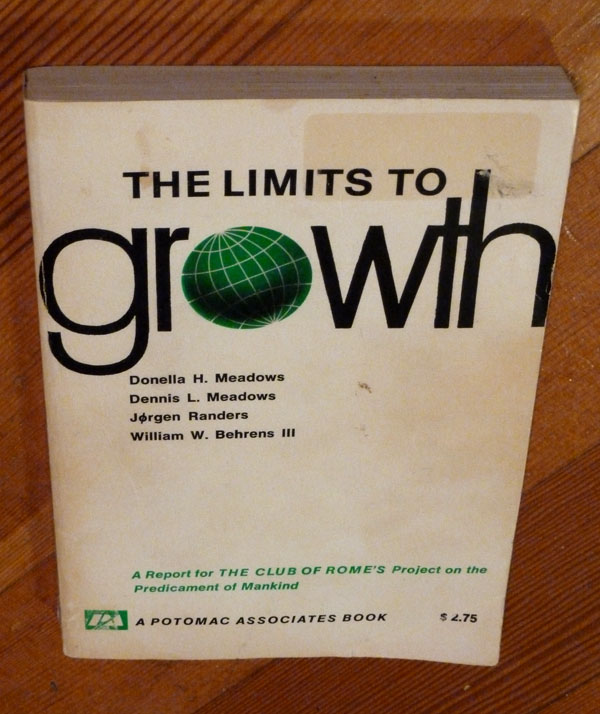
New Series: S400—Solutions For Cities In 400 Words
Last March Citytank launched with the C200 series on why cities matter in 200 words. Over the following weeks, some 70 authors contributed.
Summer’s over and Citytank is back from a mental vacation, recharged, and primed for a C200 followup series: S400
The “S” is for solutions. In 400 words.
C200 was (mostly) about why cities matter. Building on that premise, S400 will be about solutions—specific solutions for how we can better leverage the potential of cities to both improve people’s lives, and heal the planet.
Solutions big or small; pie-in-the-sky or implementable tomorrow; local or universal; liberal or conservative. Solutions ranging in scope and scale from creating a new agency for regional planning, to scrapping Seattle’s land use code and starting over, to banning leaf blowers, to painting all sidewalks purple. Anything goes as long as it has some redeeming value (i.e. if it’s stupid it had better be funny).
Got an idea about how to make cities work better? Citytank wants to hear about it, ASAP. The series launches soon. Time’s a wastin’. Please send your S400 thoughts, proposals, and drafts to: tanked@citytank.org.
The 400 word limit is a loose guideline, intended to help keep the pieces tight and focused on one idea. If you need more words that’s fine, but remember, less is often more. And images add a lot.
When I first envisioned the C200 series I never expected it to draw so many great contributions from so many great people. Can S400 do the same? I’m hopeful that together we can create something truly blogalicious. And maybe even help cities make progress to boot.
A Big Idea For Seattle: The Weather Machine
Note: For their September 2011 issue Seattle Magazine asked “dozens of prominent locals” to contribute a big idea, one favorite, money-is-no-object project that could “fix” Seattle. Here’s mine, the raw and uncensored version.
For those who tread the wonky realms of urban planning, all the best big ideas for Seattle could be neatly summed up in a single directive: Do like Copenhagen. Next please.
So allow me to propose a big idea that is way, way bigger than any of that, an idea that’s not afraid to take on the absolute worst thing about Seattle. No, not gridlock. No, not self-righteous cyclists. Nope, not even excess earnestness. Seattle’s lamest factor by far is its relentlessly damp and gray, cruelly calm, but ultimately suffocating, weather.
And the solution? A weather machine.
I got the idea from my wife who got the idea from the classic daytime soap General Hospital, that back in 1981 had arch villain Mikos Cassadine plotting to achieve world domination with a weather machine that could create blizzards. All we need is a similar machine that brings the weather of Santa Barbara to Seattle. Google could totally do it.
And the thing is, not only would some decent weather help snap us out of our collective vitamin D-deficiency-driven lethargy, it would also go a long way towards improving the stuff we urban planners endlessly fuss over. Because when it’s nice out lots more people walk and bike. The streets come alive with actual human beings exposed to the world rather than cloistered within shiny glass and metal boxes. Sidewalk cafe culture flourishes. People leave their homes, talk to each other face to face, and create this mythical thing we like to call community. Plus you get to wear sunglasses all the time.
But more importantly, I know I’m not the only one who’s thoroughly perplexed about how a city so full of smart people can be so timid when it comes to the mounting need to reshape Seattle’s built environment for the 21st Century. There is a remarkable lack of bold leadership. I’ve run out of theories except one: the weather. Can there be any other explanation for the thirty years it took to get light rail? Seattle weather turns backbones to mush.
Now, the one minor downside of my big idea is that it doesn’t exist yet. And so just in case the geniuses at Google fail to deliver the weather machine, I’ve got a plan B: Fires. That’s right, great, big, nightime bonfires in strategic locations throughout the city. Picture the vibrant social scene that would ensue around a roaring, open blaze in an empty parking lot in Pike/Pine on a drizzly winter weekend night. Bake the soggy gray right out of us, those fires would.
Alas, the fire idea would no doubt come up against our timidity complex—Catch 22. So, not to be defeated, I’ve got one last fall back, a maybe not so big, but truly humane idea for the City of Seattle: Ban effin’ leaf blowers. There really isn’t any explanation necessary, is there?
Future-Ready Cities: Why the capacity and willingness to change trump everything.
Note: This post originally appeared at alexsteffen.com.
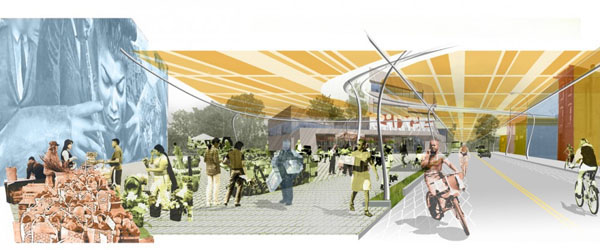
< Rendering from the OLIN team's award-winning submission to the International Living Building Institute's Living City Design Competition >
Anybody who thinks at all seriously about climate and our other planetary crises has probably thought at least a little about their own choices and prospects.
Many of us wonder whether we live somewhere that will be a good place to be in 10 or 20 or 30 years. People are starting to think about questions like, What will the local climate be like in coming years? Will the local infrastructure prove rugged in the face of natural disasters and economic shocks? How good is the water supply, the energy supply, the food supply? How heavily dependent on fossil fuel is the local economy? What will sea level rise mean to this place? A few people are actively relocating solely for big picture reasons, but right now, I hear it more often as a concern, one piece of the calculus used in making life choices.
So, how do we choose?
There are some places that are dealing with natural attributes and human legacies that will be almost impossible to address (Bangladesh, for instance, will find it very hard to adapt to sea level rise under the best circumstances; many auto-dependent American suburbs will likely experience economic distress as resource and energy costs rise; the US Desert Southwest will be extremely stressed by both anticipated heat waves and fossil-fuel dependent land uses and economies). How temperate the local climate is likely to be, how stable the surrounding ecosystem services are likely to remain, how wise (or lucky) the region has been in growing energy-efficient cities, how rich the local people are, and how much strength and integrity their national governments have — all these will matter, undoubtedly.
But I’ve come to the conclusion that readiness to act matters more than any of these. Places that invest boldly in the next decades in ruggedizing their systems, growing civic resilience and building up the local capacity for innovation, adaptation and rapid cultural change… these are the places that will be most prepared for the storms on the horizon.
Being a city region ready to meet the future (whatever it looks like) is more important than being luckiest in location or wealthiest at the moment. Successful engagement with future turmoil will demand leadership, strong civic cultures, commitment to change, tough choices, aggressive action on big systems. No city out there is moving fast enough, yet, but some are beginning to show signs of understanding the scope, scale and speed of the change demanded of them. Others look great now, but are changing only incrementally and slowly. There comes a point where lack of action means further incremental change can no longer keep up with exponential problems.
Personally, I’d rather live in a city that’s moving fast to meet the future, than one that started father ahead, but is stuck and complacent, or simply unwilling to go beyond mere incremental change. If I became confident that any city was in fact poised to be a real global leader, I’d move in a heartbeat.
I know I’m not alone. In fact, I suspect that a city that really through itself to the forefront of urban innovation (and had a clear commit to further innovation ahead) would find itself a magnet for civic talent, entrepreneurial efforts and global investment.
It may be a city few of us think of a leader now (though I think several well-established metros are positioned to rocket ahead, if they ignite bolder strategies). It may be a city in the developing world, though most of the obvious lead contenders have problems at least as big (and politics at least as stuck) as any of their developed world competitors. I doubt, unfortunately, that it will be an American city, unless an absolutely extraordinary leader comes to the front in one of them: the gridlock is too severe, the legacy of sprawl too large, the civic culture too frayed and poisoned. I would love to be proven totally wrong.
Wherever it may emerge, the edge a leading bright green city gains in the next 20 years could put it in a position of increasing prosperity for a century, even in the midst of hard and turbulent times. The solutions it invents and tests could also benefit the entire world, even help smooth some of the rough waters ahead. The best possible scenario would be one in which several (or many) cities hurl themselves into fierce competition to lead in a bright green urban boom.
>>>
Alex Steffen is one of the world’s leading voices on sustainability, social innovation and planetary futurism. He is a writer, public speaker and strategy consultant.
Hey there Seattleites, remember back in late fall 2009 right after McGinn got elected mayor when Alex Steffen challenged the City of Seattle to achieve carbon neutrality by 2030, and then the City Council adopted that idea as a 2010 priority, and then Councilmember Mike O’Brien convened an army of volunteers to address eight components of greenhouse gas emissions, and then the Office of Sustainability and Environment (OSE) contracted out a carbon neutrality study, and hey, have you been wondering what’s up with all that lately?
Well, that carbon neutrality study by the Stockholm Environment Institute (SEI) is done, and it’s action packed. The proposed scenario would achieve steep cuts in greenhouse gas emissions in three main buckets: (1) transportation mode shift away from private autos: (2) greater energy efficiency in both vehicles and buildings: and (3) switching to less carbon intensive energy sources.

< Greenhouse gas emissions for the Seattle carbon neutral scenario; Stockholm Environment Institute >
In more detail, here’s what the study says could achieve a 90% reduction in Seattle’s per-capita emissions of greenhouse gases by 2050 compared to 2008 levels:
- 50% reduction in travel by light duty vehicles (replaced by walking, biking, and transit)
- 50% increase in vehicle energy efficiency
- Electrification of 80% of the vehicle fleet
- 50% increase in building energy efficiency overall
- By 2030 all new buildings achieve 75% energy savings
- Energy retrofits penetrate 90% of all existing buildings and achieve 40 to 75% energy savings
- 90% of existing residential buildings and all new single family use electric heat pumps
- For new multifamily buildings, and for new and retrofit commercial buildings, half use district energy, and half use electric heat pumps
The proposed scenario was intended to be aggressive, not over-the-top, but no doubt the above bullet points would take some serious doing. To achieve the required mode shift to transit, for example, the assumption was a five-percent annual increase in transit service from 2010 to 2020 followed by a constant annual increase (equal to the 2020 increment) thereafter. That adds up to a huge boost in transit service, and right now we may be headed in the opposite direction. The assumed scale of building energy retrofits is way, way beyond anything that has ever been attempted, and would require a massive up-front investment.
Of course, that’s the reality of addressing climate change. We’re actually going to have to make an effort, imagine that. We could be—and should be—aggressively moving forward with the above strategies already.
There’s tons more fodder for debate and deeper questions raised by the SEI study (e.g. What happened to the 2030 target? What about consumption-based emissions? Can we afford it? etc.), and we can expect to be hearing a lot more about all of it as OSE gears up for a major update of Seattle’s Climate Action Plan over the coming year. For now I’ll take you back to where it started and leave you with the video below, Alex Steffen’s July 2011 TED talk on carbon zero cities:
Note: This post originally appeared on Sightline, and is part of their series: Making Sustainability Legal. One point to add: We should also consider how the taxi license shortage could be leveraged to increase the sustainability of the fleet, e.g. by giving priority or reduced fees to higher mileage cabs like Priuses. – Dan Bertolet
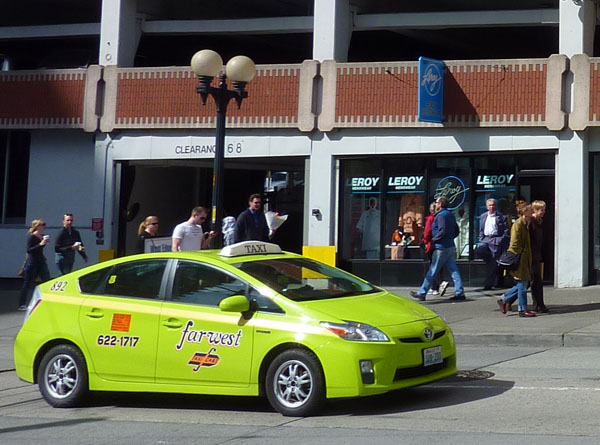
What if the Northwest’s cities legally capped the number of pizza delivery cars? What if, despite growing urban population and disposable incomes, our Pizza Delivery Oversight Boards had scarcely issued new delivery licenses since 1975? Pizza delivery would be expensive and slow; citizens would rise up in revolt.
Substitute “taxicab†for “pizza delivery†and you have a reasonable facsimile of the taxi industry in Portland, Seattle, and Vancouver, BC: tightly restricted taxi numbers, high fares, and low availability.
Plentiful, affordable taxis facilitate greener urban travel. They help families shed second cars, ride transit more often, and walk to work on could-be-rainy days. They fill gaps in transit systems and provide a fallback in case of unexpected events.
In the Northwest’s largest cities, however, local ordinances enforced by taxi boards suppress the entry of new cabs onto the streets. They impose arcane and ultimately farcical management principles reminiscent of Soviet planning. Imagine teams of pizza regulators pawing through discarded receipts and pizza boxes to determine whether demand for pizza delivery markets are “oversaturated,†and you won’t be far from the truth. Restricting taxicab licenses undermines passengers’ mobility, local economies, and—by encouraging driving—our natural heritage; uncapping cabs would allow market competition to bolster all three.
As shown in the figure above, at present, the Northwest’s largest cities have fewer cabs per capita, and higher fares, than many US cities. Seattle’s 1.4 cabs per 1,000 residents is twice Portland’s 0.7, and well above Vancouver’s 1 cab per 1,000. But all our cities lag. Washington, DC, has more than 12 cabs per 1,000 residents; Las Vegas has almost 6; and San Francisco has 2. Meanwhile, the cost of a typical, five-mile trip is $16.50 in Portland, $17.25 in Seattle, and $21.57 in Vancouver. Washington, DC’s typical fare is just $11.50.
Consider the efforts of Portland’s Transportation Board of Review, which has the power to issue new taxi licenses but is also charged by city law with monitoring “market saturation factors.†It is supposed to avoid market oversaturation, something every other market—from pizza delivery to home remodeling—manages to do just fine on its own, without benefit of a board. In Portland, the rules actually require applicants to prove that a new taxi license is needed. Imagine if Pizza Hut had to demonstrate to the Pizza Delivery Board that it needs another driver for the Super Bowl.
In Vancouver, the Passenger Transportation Board‘s rules are slightly more flexible than Portland’s. They have allowed a trickle of new cab licenses over the years, but they have screened out many applicants, too. A Vancouver cab company seeking a new license is supposed to prove the taxi market isn’t already too full, and that can be a complex question to answer. In other markets, entrepreneurs figure out the answer to their own satisfaction, then see if they’re right by risking their own time and money. New pizza parlors do not have to show city regulators that their delivery service is needed.
Worse, in Vancouver, cab companies may petition against a competitor’s new license. When Pizza Hut applies for an extra delivery license for the Super Bowl, in other words, Domino’s has a right to challenge the application. In 2010, the board rejected some 43 percent of requests for new permits, despite the city’s high taxi fares and paltry cab numbers.
Seattle’s Department of Executive Administration, like taxi boards to the north and south, tries to divine the number of taxicabs Seattle can support without oversupplying the market (whatever that means). Its method is to comb through an enormous database of “weighted average taxi response times†to look for signs that wait times are getting worse. Making the heroic assumption that Seattle’s status quo of long waits and fruitless cab hunting are acceptable, it looks for signs of further deterioration before considering new licenses.
A better test would be whether anyone is willing to pay for a taxi license. Guess what? Seattle medallions currently trade for $100,000, when they’re for sale at all. When the city offered 15 new licenses for wheelchair accessible taxis in 2009, 723 drivers applied. Vancouver taxi licenses have sold for up to CDN$500,000. (In New York, taxi medallions were selling for close to $1 million in June.) The explanation of these bubble-like prices is economics: restricting taxi supply increases the profitability of each cab. Holders of taxi licenses can fill their cabs more of the time and keep the meter running.
In the Northwest as across the continent, taxi regulation is dominated by license caps and fixed rates, but that isn’t the only way. Washington, DC, has no limit on the number of cabs. It has plenty of taxis and low prices. The capital city does regulate taxis, insisting, for example, that drivers and vehicles meet safety criteria, that fares be clearly posted, and that meters be accurate. But DC law imposes no lid on taxi licenses. That’s good sense. When we import that approach to Portland, Seattle, and Vancouver, we’ll have more-robust urban taxi fleets and we’ll be able to leave our own cars home more of the time.
>>>
Guest blogger Vince Houmes of Seattle is a longtime Sightline supporter and hobbyist policy researcher.
>>>
Sources of charts: Data from the Chicago Dispatcher, with updated city populations (from Wikipedia) and updated numbers of Seattle and Vancouver taxis. An “average trip†is 5 miles long, with 5 minutes of waiting. Per-capita numbers are for city, not metro, population. Vancouver cab prices vary slightly, but a reasonable estimate may be found here.
Save our Soul {SOS} Seattle: Why the Seattle arts and heritage community should vote to reject the tunnel

Introduction
Six years ago, when I began working as an “artist in transportation,†I was resolutely apolitical. My sole interest was to explore how the 520 Bridge Replacement Project would impact the Arboretum’s rich cultural heritage, natural beauty and living collections. I remember explaining my ideas to a prominent Seattle arts leader. He politely scoffed. “The 520 is about big cars, big money and big politics,” he said. His meaning was clear: There’s no place for an artist in this debate. I was stunned.
Since then, I’ve come to see his point. It is incredibly difficult to influence the outcome of a mega transportation project. To have any hope of doing so, you must engage politically. So I have. Over the past few years, I’ve attended so many meetings that I now consider public forums to be my studio space. I volunteer my time to do this work because transportation projects are largely exempted from percent-for-art programs, and yet they’re as much about art and history as they are about counting cars.
Or they should be. Collectively, the cultural community understands our history as manifested in historic buildings and landscapes; we can envision the impact on these spaces in all its complexity. When it comes to advocating for our city’s cultural spaces and heritage, our knowledge and expertise are critical.
In the essay that follows, I’ve done my best to explain the aspects of the tunnel project that I think the cultural community will care most about. The tunnel debate has been intensely polarizing, and up to now, I’ve tried to stay open to the idea that we could protect Seattle’s cultural resources under any plan, but the more I learn about the tunnel, the more I realize that it puts too much at risk. We need to reject the tunnel now.
Your ballot has arrived.
Please vote.
Protect Seattle’s arts and heritage future.
Reject Referendum 1.
Reject the Tunnel.
Great places: smart density as part of economic flourishing
Note: this post originally appeared on Grist.

< Bring people together in a great place and great things happen. >
So far I’ve written that great places are green and groovy. (Yeah, I said groovy.) Lest I make the whole notion sound like a smelly commune, though, it’s worth noting that great places are also fecund: They generate economic and social capital. Done right, density can be an engine of prosperity. Business executives should love great places just as much as hippies like me do.
Here’s the basic idea: When smart, skilled people start to gather in a place, the process becomes self-perpetuating. More smart, skilled people show up to be near the others. And the more smart, skilled people you get close together, the more you reduce transaction costs and increase “knowledge spillover,” which leads to commerce and innovation. That’s true not only for individuals but for industries and research institutions (universities, labs, etc.). In economic nerdspeak, this phenomenon is known as the “economies of agglomeration.” It concrete terms, it means, as Ed Glaeser put it recently, that “wages and productivity rise with density.”
There’s a lot of research going on around this now, and I don’t want to overstate how settled the scholarship is, but the basic idea is pretty intuitive. After all, the metropolitan areas where people and businesses cluster are the engines of the U.S. economy. America’s top 100 metropolitan areas cover about 12 percent of its land but produced, in 2008, around 75 percent of its GDP. The top six metros alone generated more than 25 percent. According to a 2009 analysis by Brookings, in 47 out of 50 states, the bulk of the economic output comes from metropolitan areas. In 15 states, a single large metropolitan area produces the majority of economic output. Cities are also the source of most patents, a reasonable proxy for innovation.
So cities are already where the economic action is. And managing metros well is only going to get more important in coming years. Consider a few demographic and economic trends that are driving accelerated urbanization: The U.S. population is getting older on average; Baby Boomers are retiring, looking to downsize and get closer to amenities. Men and women are marrying later, meaning there are lots more young, single people looking for vibrant job and mating markets. When they do get married, they’re having fewer kids (a trend exacerbated by the recession), and smaller families tend to live closer to urban cores.
In short, lots of people are headed for cities, and density, which declined in the ’80s and ’90s, is destined to head back up. And while economies of agglomeration are not as strong for old-school, land-intensive businesses like heavy manufacturing, warehousing, and big-box retail, for the innovative service and knowledge jobs that increasingly dominate the U.S. economy, getting people in close proximity is a huge boost. All those incoming people could be an enormous asset for cities that know what to do with them.
So what can cities do to maximize the benefits of this inflow? What makes for an economically great place? I asked Bruce Katz, head of Brookings’ excellent Metropolitan Policy Program, and he emphasized that smart growth alone is not enough. “What you want is great places that are built on great economic bases,” he said. “The two really need to go together. What I argue for is economy-shaping, talent-preparing, and placemaking, all together.”
So smart density cannot yield economic flourishing all on its own; cities need to focus on their tradeable sectors, research institutions, and worker training programs. Nonetheless, smart density lays the groundwork for agglomeration economies to emerge and can accelerate and strengthen them when they do. So how can places do density right, to encourage great (economic) places to take root and grow?
Trying to accommodate population inflow with low-density sprawl doesn’t work. First, it increases the cost of infrastructure (roads, sewers) and services (police, fire departments). Given the grim state of federal and state budgets, “the fiscal arguments matter even more today,” said Katz. “If you don’t have those costs, you’re able to invest in what matters. Density yields fiscal rectitude.”
Second, sprawl creates congestion. And as the 2010 Urban Mobility Report reveals, the costs of congestion are getting out of hand: “measured in constant 2009 dollars, the cost of congestion has risen from $24 billion in 1982 to $115 billion in 2009.” If that doesn’t convince you, long commutes also cause “obesity, neck pain, loneliness, divorce, stress, and insomnia.” People tend to overestimate the hedonic benefits of owning a car, in part because they underestimate how much being in traffic suuucks.
And third, sprawl thins out the labor pool, which reduces innovation and productivity. Conversely, density that’s well-served by multi-modal transportation systems has the effect of “thickening” the job market, giving more people better access to more opportunities. A 2000 paper by scholar Robert Cervero found that “employment densities and urban primacy are positively associated with worker productivity.” (There’s a bumper sticker for you.)
Density served by effective transit systems — “accessible cities” — can also serve the cause of economic justice, by widening the “laborshed” of low-income people without cars, but “you really have to be intentional about that,” Katz notes. “You’ve got to build in inclusionary zoning.” But that’s probably a subject for another post …
Anyway, accessible cities are attractive to the very people cities need to attract these days: the educated, the skilled, the creative, the entrepreneurial. What else do those folks want out of a place, besides robust economic opportunities and walkable, liveable communities? Well, they want urbane and tolerant culture, plentiful amenities, and competently delivered services. In short, they want great places. As Richard Florida argued in a series of posts at The Atlantic last year, “human capital density, creative class density, artistic and cultural density, [and] high-tech and innovation density” are often found in the same places:
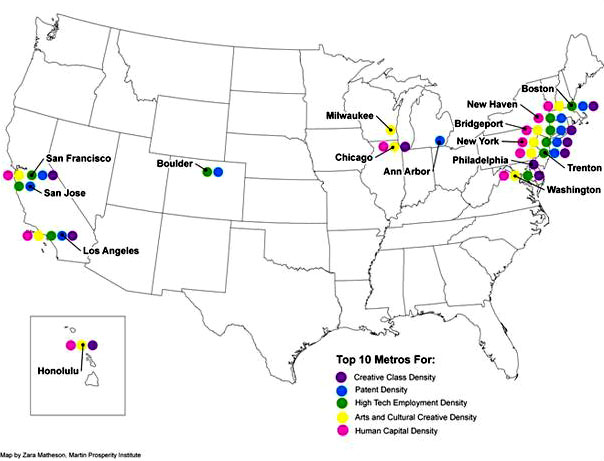
That’s no accident. The brightest and most ambitious people tend to follow one another to the same places. They cluster.
 Obviously, one question for progressives is how to produce more bright and ambitious people. That gets into education policy, pre-natal care, and all sorts of other areas. But another, equally important question is, how can we create more places where such people gather and flourish? How can the benefits of smart density, reflected in the map above, be spread more widely? What can a national political movement do to empower metropolitan areas to become great places, so that more Americans have a chance to live in one? That’s what this series is about; that, I argue, is what progressive politics should be about.
Obviously, one question for progressives is how to produce more bright and ambitious people. That gets into education policy, pre-natal care, and all sorts of other areas. But another, equally important question is, how can we create more places where such people gather and flourish? How can the benefits of smart density, reflected in the map above, be spread more widely? What can a national political movement do to empower metropolitan areas to become great places, so that more Americans have a chance to live in one? That’s what this series is about; that, I argue, is what progressive politics should be about.
>>>
David Roberts is staff writer for Grist. You can follow his Twitter feed at twitter.com/drgrist.
Writing Code For More Sustainable Neighborhoods
Editor’s note: This article originally appeared in Crosscut. Hint: Food for thought regarding Seattle’s Comprehensive Plan Update.
>>>

< Mayor McGinn and Councilmember Conlin announce the new recommendations; photo by Chuck Wolfe >
A recent joint announcement of recommended regulatory-reform measures for neighborhood development had Mayor Mike McGinn and Seattle City Council President Richard Conlin focusing on creating new jobs. That angle was the attention grabbing headline in the major media.
Ordinarily, reforms of urban land-use regulations come about after a lot of pushing and pulling by consultants and organized pressure groups. These reforms were different. They embraced community input by putting together a roundtable of interested parties to come up with some evolutionary Code updates, deriving from the issues de jour of recent years — including backyard cottages, revised approaches to multifamily development, parking requirements, street-level retail, and other arcane elements of urbanist lore.
This month’s joint announcement is the outcome of a six-month process, discussed in detail below. It meshes with a March 2011 City Council resolution adopting guiding principles for strengthening and growing Seattle’s economy and creating employment opportunities. The recommendations were released for public review and comment, due by July 25.
Full disclosure: I am an active roundtable member, which gave me a ringside seat but also makes me an advocate.
The roundtable behind the recommendations was composed of a broad alliance of business, environmental, and neighborhood representatives. Variants of the roundtable were convened by Mayor McGinn for initial conversations early this year, and a core group worked collaboratively on the announced recommendations. In a departure from past governance practices, the group is not an appointed “blue ribbon commission,” nor does it have staff. It has met regularly (often many times per month), vetted issues and approaches, and worked with city officials to brainstorm solutions.
The current recommendations are in reality an early stage of the roundtable’s work, and in the eyes of some group members, only a small tilt towards further revisions to the Land Use Code. Yet the proposals evince some sense of today’s urbanism agenda — a move away from prescription and favoring implementation of tweaks, clarifications, and small expansions of certain non-traditional housing, business, and multi-modal transportation initiatives already under way.
Further, given the urgency of enhancing employment, the recommendations embrace immediate, simplifying measures, intended to reduce complexity and increase flexibility, in turn decreasing the costs in time and money of starting and maintaining businesses and building new, more affordable housing.
While the initial menu of fixes is designed to avoid duplication and enhance the prospect for new construction, the group will continue to work on longer term issues in association with pending revisions to Seattle’s Comprehensive Plan. Those revisions are mandated by the Growth Management Act and championed through a dynamic update process recently launched by the Department of Planning and Development and the Planning Commission.
The group’s goal is broad and ambitious: to help Seattle residents live closer to where they work. The starting place is to simplify and update the city’s Land Use Code, what Sightline’s Eric de Place calls “making sustainability legal.”
This broader effort is akin to something that I first suggested here in Crosscut amid the elections of 2009. I proposed a frank recognition of traditional land use dilemmas in the City and a move towards contemporary land use regulatory approaches focused less on incremental brush wars and more on holistic and sustainable tools implemented elsewhere. Examples of this new approach, I wrote, are form-based codes, citywide transit-oriented development policies, and ongoing integration of transportation, land use, and underlying natural systems.
Let me now provide a summary of the announced recommendations. More detailed discussion of each recommendation (with the addition of a proposed modification for height measurement) appears in public notice materials assembled by DPD here as summarized from DPD Director Diane Sugimura’s Report and Recommendations, which urges adoption of the Roundtable’s recommendations.
Encourage Home Entrepreneurship The Roundtable embraced the assumption that the home-based business is an incubator for new ideas which create jobs. The recommendation would allow property owners to operate home-based businesses (“home occupations”) in any structure, as long as impacts to surrounding properties are minimized, and any associated alterations to structures are permitted in the underlying zone. Other new provisions would allow home-based businesses to advertise on the internet, allow up to two non-resident employees (currently limited to one), and allow more flexibility for weekday deliveries with limits focused on heavy vehicles.
Concentrate Street-Level Commercial Uses in “P-Zones.” The Roundtable acknowledged that ground floor commercial uses make sense in shopping and other pedestrian areas, and is a major premise of the reinvented and walkable American city going forward. However, recessionary times have made clear that more flexibility is needed outside of those areas to build buildings without ground-floor commercial spaces. This recommendation will drop the ground floor commercial requirement outside of pedestrian-overlay (P) zones, and would apply to approximately 80 percent of Commercial (C)- and Neighborhood Commercial (NC)-zoned frontages on arterials throughout the city.
Enhance the Flexibility of Parking Requirements The Roundtable recognized recent debates over the cost of parking, and agreed with the premise that as Seattle’s transit service improves, demand for on-site parking will shrink. This recommendation will allow the market to determine how much parking should be provided in locations within one quarter mile of good transit service (generally, those with at least 15 minute headways). It eliminates minimum parking requirements for residential or non-residential uses in such locations (such minimums currently apply only to residential uses within urban villages). In addition, this recommendation modifies minimum parking requirements for major institution uses in urban centers to be the same as other nonresidential uses.
Allow Small Commercial Uses in Multifamily Zones The Roundtable acknowledged the trend towards re-establishing the small corner store amid the urban fabric. Historically, residential zoning has often been an impediment to locating such small commercial uses close to where people live. This recommendation would allow small corner stores in “Lowrise 2 and 3” multifamily zones in urban centers and light rail station area overlay districts — thereby providing additional retail opportunities already present in “Midrise” and “Highrise” multifamily zones.
Expand Options for Accessory Dwelling Units. The Roundtable recommended additional flexibility for Accessory Dwelling Units (ADUs) through allowance of backyard cottages on “through lots” (lots that front two streets), essentially providing for a “backyard” in cases where the Code has historically interpreted two front yards. The recommendation also allows more flexibility for the height of backyard cottages on sloping sites and clarifies that ADUs are allowed in all housing types (including townhouses, rowhouses, and in multifamily housing in NC zones).
Mobile Food Vending/Temporary Uses The Roundtable endorsed a continuation of flexibility to non-permanent uses which help enliven neighborhoods. This recommendation would allow vending carts on private property where other commercial uses are permitted (“Lowrise 2 and 3” zones in urban centers and light rail station areas, and in “Midrise” and “Highrise” multifamily zones). Example: a coffee cart in front of an existing restaurant. This recommendation would also extend the permitted days and hours of farmers markets, and make temporary use permits easier to obtain for street food and other vending to expand their duration period. It complements other street food proposals under consideration that address activities within public rights-of-way.
Change State Environmental Policy Act (SEPA) Implementation to Avoid Redundant Review and Provide Amended Review Thresholds. The Roundtable recommended that the city take advantage of opportunities to streamline and combine SEPA review with other aspects of regulatory review for proposed residential and mixed-use projects in designated growth centers, such as urban centers and light rail station areas The goal of SEPA is to minimize environmental impacts, but 1995, 2003, and 2009 legislative amendments to SEPA allow streamlining of environmental review to use development standards within the Land Use Code to address major environmental impacts.
This recommendation would codify SEPA conditioning authority for transportation analysis and mitigation in the Land Use Code (as a Type I, non-appealable, decision) in exchange for raising the SEPA unit and square footage thresholds for individual projects in urban centers and light rail station areas to 200 dwelling units (250 in the “Downtown Urban Center” designation ), and 75,000 square feet for commercial uses in mixed-use development. The Roundtable’s intent? By putting mitigations directly into city standards, this recommendation is intended to create more certainty that a project’s impacts will be addressed, while shortening the permit review process.
Which brings us back to the jobs theme at the press conference. As announced, this SEPA aspect of the proposal could result in 40 new construction projects with 100 to 250 units each year. The Seattle Building Trades Council estimates that 2,400 direct jobs in skilled construction trades could be created through such measures.
>>>
Chuck Wolfe, a Seattle environmental and land-use attorney, holds a master’s degree in regional planning. He blogs at myurbanist.
Bringing Sexy Back to the Comp Plan

Whether you call us the stewards, champions, or guardians of Seattle’s Comprehensive Plan, it’s undeniable that the Planning Commission has a very special relationship with Toward a Sustainable Seattle, that massive, sprawling document that guides our city’s growth. Yes, perhaps it is only a Commissioner that feels drawn to tend the Utilities Element like a prizewinning rose, or who commits the Housing Appendix to memory. But allow us to unabashedly confess to having spent many a stormy evening, glass of wine in hand, passionately debating the merits of Land Use Policy 59 or a proposed amendment’s effect on the Future Land Use Map. Say what you will, for a Planning Commissioner this makes for a scintillating evening.
Okay, we recognize that most people don’t get hot and sweaty in the same way we do when there’s talk about a major update to the Comp Plan. We get that it doesn’t titillate in the same way as do backyard chickens, or the prospect of mobile food pods, or (and this might be understandable) the placement of adult cabarets. But the thing is, it should.
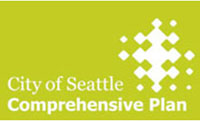 For those of you who have never cracked the big brown binder, the Comp Plan is where the framework policies for all these decisions get made. This is where we lay out how we should focus new jobs and housing, and what our neighborhoods should look like. The Comp Plan guides how we invest city dollars in transit, pedestrian and bike connections, parks, libraries and community centers. In truth it is the genesis, the framework from where all big-picture land use, growth, transportation, and housing decisions start. The Washington State Growth Management Act requires it.
For those of you who have never cracked the big brown binder, the Comp Plan is where the framework policies for all these decisions get made. This is where we lay out how we should focus new jobs and housing, and what our neighborhoods should look like. The Comp Plan guides how we invest city dollars in transit, pedestrian and bike connections, parks, libraries and community centers. In truth it is the genesis, the framework from where all big-picture land use, growth, transportation, and housing decisions start. The Washington State Growth Management Act requires it.
After all, the place your backyard chickens call home is also the economic center of the region, expected to welcome at least 120,000 new residents and 115,000 new jobs by 2031, with more likely as Seattle proves an increasingly attractive alternative to the suburbs. Now is a critical time for a robust public dialogue on the opportunities and challenges Seattle faces as we grow over the next 20 years.
If you care about keeping Seattle affordable, creating neighborhoods where you can walk to what you need, prioritizing where we spend city dollars, becoming a climate-friendly city, or promoting great urban design, then it’s time to bring sexy back to the Comp Plan and get in on the major update process starting now.
What difference might it make? Consider that in 1994 light rail was a distant dream for the future, composting was for hippies, and the idea of concentrating housing and jobs around frequent transit in Urban Centers and Villages–now considered a no-brainer–was practically causing riots in the streets. Change is certain, and will bring us both new opportunities and new challenges. It’s up to us to help the city think through how we address all of these important issues and help shape the future of Seattle.
Identify your priorities for Seattle by taking the survey: Â http://www.surveymonkey.com/s/SEACompPlan.
>>>
Josh Brower and Leslie Miller are the Chair and Vice Chair of the Seattle Planning Commission. The Commission, comprised of 16 volunteer members appointed by the Mayor and the City Council, is the steward of the Seattle Comprehensive Plan. In this role, the Commission advises the Mayor, City Council, and City departments on issues that shape Seattle including land use, transportation, housing, and environmental policy.
I’ve hacked out an absurdly huge volume of words criticizing Seattle’s proposed deep-bore tunnel ever since it was first announced back in January 2009 (see list at the bottom of the post). And I have mainly hit on the big picture, that is, why the tunnel is such a bad investment given massive trends such climate change, peak oil, sprawl, public health, and evolving demographics and preferences—in short, largely the environmental point of view.
So it was gratifying to see a cadre of my favorite environmentalists—whose names are much bigger than mine—going public last week with such a powerful indictment of the tunnel. To me, the heart of the issue is summed up well in the last sentence:
What our community needs now, in these dark economic and political times, is a brave and pragmatic, “Hell, yes! We can do better than a buried highway.â€
Interestingly, however, much of their “environmental” argument concerned functional aspects. In particular, the remarkable truth that—as was first reported by Sightline, and then expanded on by the Stranger—modeling in the Final Environmental Impact Statement (FEIS) shows that in terms of traffic congestion impacts, a tolled tunnel is barely better than closing the viaduct and doing absolutely nothing else.
Continuing that line of thought, if we assume for the moment that the only thing that matters in the world is traffic congestion, then the key metric is vehicle hours of delay (VHD). The table below shows the FEIS’s projected VHD in 2030 for the tolled tunnel, the tolled elevated, the I5-surface-transit option (ST5), and closing the viaduct.

< Vehicle hours of delay (VHD) in 2030 for various options; source: WSDOT >
A few things pop out. First, ST5 is the clear winner when it comes to mitigating congestion in Seattle’s city center. Note that ST5 is the very plan that the pro-tunnel “Let’s Move Forward” campaign has disparaged as “McGinn’s surface gridlock.” Also, given the numbers showing that ST5 is a better performing solution for downtown Seattle than the State’s preferred tunnel option, it’s ironic that the Downtown Seattle Association is the largest single contributor so far to Let’s Move Forward.
Second, for the four-county region, compared to the tolled tunnel ST5 would only result in about one percent more vehicle hours of delay. Is that even within the margin of error for the modeling? Nevertheless, as reported as seattlepi.com, when the FEIS was released, State officials touted preserving regional mobility as the justification of their choice of the tunnel. And apparently seattlepi.com bought it, translating that one percent difference into a hyperbolic headline that reads “Surface-transit would clog regional traffic.”
Third, in terms of vehicle hours of delay ST5 performs better—both locally and regionally—than the tolled elevated, which was one of the official alternatives analyzed in the FEIS. Yet the State decided in advance that ST5 did not merit full consideration. By the way, that would be the same ST5 that was one of the original two recommended options that came out of the year-long stakeholder process, that has been vetted in multiple studies (here, here, here, here, and here), and that costs about a billion dollars less than the deep-bore tunnel. It’s hard not to conclude that the State’s dismissal of ST5 can only be the result of either an attempt to stack the deck, or incompetence.
Given the modeling data, an objective observer might conclude that choosing the tolled tunnel over ST5 comes down to Seattle taking one for the (regional) team. That is, Seattle’s mobility must get worse so that the region’s mobility can get better (even if only one percent better). And maybe that really could be a justifiable choice, depending on the circumstances. But I strongly suspect that’s not how most tunnel boosters who live in Seattle would prefer to see it. And it’s certainly not how most of the State’s electeds have postured on it, seeing as they passed legislation making Seattle property owners liable for cost overruns.
So then, back to the the original assumption that nothing matters more than moving more cars faster. During the latter half of the last century, that was pretty much the operative rule for transportation planning. But now we’re supposed to know better. Now that we understand the web of connections between transportation, land use, and sustainability, we should no longer accept small, narrowly focused gains at the expense of holistic, long-term solutions. For example, a two-mile underground freeway might result in a relatively small, local reduction in runoff pollution to Puget Sound, but a paradigm-shifting plan like ST5 has the potential to catalyze systemic change, and the resultant reduction in car-dependence would have a far greater cumulative positive impact.
The challenges and opportunities of the coming decades are so profound that we’ve got to do better than settle for major infrastructure investments based on last-century thinking. And to better appreciate why so many of us so-called environmentalists are stubbornly resistant to further compromise—as in, just build the tunnel because we have to do something—I would recommend Bill McKibben’s latest book, Eaarth, the thesis of which is that we no longer live on the same planet, and we better start planning our future accordingly. McKibben, founder of 350.org, recently had this to say regarding Seattle’s deep-bore tunnel:
‎The era of expensive, vulnerable, car- centric megaprojects is ending around the world, as more and more cities plan for a durable, resilient, diverse future. Not cars-in-a-pipe, but bikes, buses, and all the things that make a city a city.
If you agree, Protect Seattle Now, the campaign to reject the “tunnel referendum,” could use any support you can offer.
>>>
Still Not Digging The Tunnel Epilogue: The Dan Bertolet Tunnel Reading List:
- 01.23.09: Why The Tunnel Is So Wrong
- 01.30.09: Close the Schools, Dig The Tunnel Redux
- 02.02.09: Tunnel Head
- 03.05.09: Have Mercy
- 03.14.09: A Post About Something Inspiring. No, Really!
- 04.02.09: Drilling, Baby Drilling
- 05.12.09: “If no one wants to pay for it, why build it?”
- 05.21.09: Climate Change Doublethink
- 07.03.09: The Deep-Bore Tunnel Is A Done Deal (Just Like The Monorail Was)
- 08.13.09: Exclusive Offer: 2-mile Deep-bore Tunnel Absolutely Free! Limited Time Offer! Order Now!
- 10.17.09: One Issue
- 10.18.09: Tunnel Memorandum of Agreement Petition
- 10.26.09: A Response To The Earthquake Video
- 12.17.09: Tunnel Resurfacing
- 01.10.10: Don’t Worry, It’s Probably Nothing
- 02.04.10: Give That Tunnel Some Air
- 02.11.10: Re-branding is Magic: Meet the Tunnel+Transit Coalition
- 03.02.10: What Would Vancouver Do?
- 04.12.10: The Cost Overrrun Time Bomb
- 05.24.10: Council Should Unite Behind McGinn On The Cost Overrun Provision
- 06.08.10: Licata Nails It Re: The Tunnel
- 06.30.10: Parsing Conlin’s Tunnel Pitch
- 07.12.10: Let’s Get One Thing Straight: The Tunnel Is Not The “Green Alternativeâ€
- 07.16.10: Tunnel Mania
- 07.22.10:Â Let’s Give New Orleans Our Tunnel
- 07.23.10: Hey Tunnel Agreement: Got Transit?
- 08.03.10: Pretending That No Other Plan Exists
- 09.07.10: Cars and Cities
- 09.24.10: Only The Deep-Bore Tunnel Can Save Us From The Horrors Of City-Wide Gridlock!
- 12.16.10: Dead Tunnel Walking
- 03.20.11: Do What You Have To Do
- 03.23.11: Now That We’re On The Subject Of The Tunnel…
- 04.21.11: If Nothing Else, Maybe We Can All Agree On This: The Viaduct Is Ridiculous
- 05.11.11: What Really Causes Gridlock? Cities Do.
Dynamic Metropolitan Areas Depend on Transit, So Pass the Congestion Reduction Charge, Please
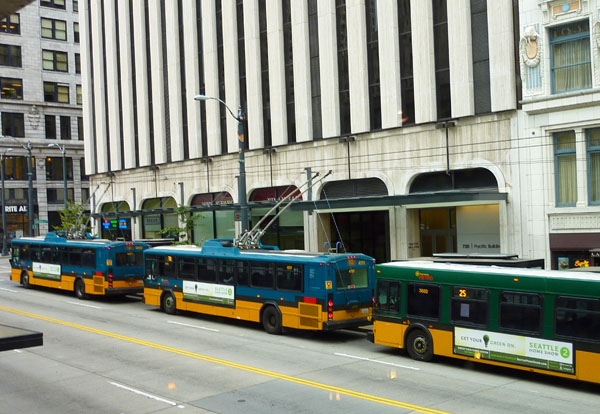
< Metro buses on Third Ave in downtown Seattle: photo by Dan Bertolet >
The Rockefeller Foundation published a report in 2008 declaring the twenty-first century to be the century of the city. For the first time in world history, a majority of the earth’s population resides in cities. Foreign Policy magazine devoted an extensive series to cities in late 2010, noting that: “The 21st century will not be dominated by America or China, Brazil or India, but by the city. In an age that appears increasingly unmanageable, cities rather than states are becoming the islands of governance on which the future world order will be built.†84 percent of Americans live in metropolitan areas, and it is within these diverse and dynamic regions that policies to nurture successful economies must be formed. Our economic competitors are now scattered around the globe; even being the best in the U.S. is no longer good enough.
Dynamic metropolitan areas, now more than ever, depend on transit systems. Urban areas concentrate jobs, culture and entertainment in ways that cause cross-pollination and innovation to flourish. Public transit systems are the arteries that allow these regions to circulate, to acculturate newcomers and immigrants, and to provide opportunity and access to all regional residents, at a scale in which automobiles are not suited. International quality of life surveys, such as those by Mercer, the Economist Intelligence Unit, and Monocle, assume that a comprehensive and convenient transit system is a part of the package for a high quality city. Needless to say, American cities do not rank high.
Several American metropolitan areas, however, such as Salt Lake City, Dallas and Denver, have made bipartisan commitments to strengthening their transit system, including significant investments in new rail transit. These metro areas realize that in the 21st century, transit investment is not a luxury, not a sidelight, not a divisive partisan issue, but a core component of metropolitan success and a measure of competent governance. Transit also responds to two emerging demographic factors: the rapidly growing elderly population, who may not be able to continue driving, and the effect of the millennial generation, which is less likely than their parents’ generation to have a driver’s license or to own a car.
The Seattle metropolitan area has led the way in transit commuting in the U.S. A Brookings Institute report noted that only four cities have lower rates of solo automobile commutes than Seattle, and transit usage increased remarkably during the 2000’s. 30 percent of commuters throughout the region chose other modes, and among workers in downtown Seattle, a recent survey showed that only 35 percent drove alone. 40 percent used public transit. The public transit that the King County Council currently has the power to protect, or atrophy and neglect. Ridership records show that over the past 15 years, public transit has transitioned from predominately trips between Seattle’s neighborhoods, to an essential component of regional transportation. Since beginning in 1999, Sound Transit has expanded to provide 70,000 customers daily with regional transit offerings. Meanwhile, ridership on Metro transit non-Seattle routes has soared, demonstrating increasing demand for regional transit service. As our freeway system has reached capacity a growing number of commuters have responded by switching to regional transit.
A robust public transit system is no longer an optional item for King County, expendable in lean fiscal times. Public transit has become an integral component of our regional economy, and increasingly a driver and enabler of further economic growth in the job centers of King County. All the discernible trends show that the importance of transit in metropolitan areas is increasing. If you support further economic development in King County, if you support integration of immigrants and low-income persons into our society, if you support retaining and strengthening our region’s competitive edge in an increasingly global marketplace, then support using the authority granted by the State to maintain funding for King County Metro transit. Support the $20 per year cab tab fee known as the Congestion Reduction Charge.
>>>
Chad Newton is an Environmental Engineer and Seattle resident.
Memo to state officials: It’s the cities, stupid!
Note: The following post originally appeared on Crosscut. This C200 post hit on similar themes.

< Seattle, via Wikipedia Commons >
A few weeks ago I happened to be channel hopping and watched a panel discussion monitored by Joni Balter of The Seattle Times at a meeting of the Seattle City Club. The panel consisted of two members of the state legislature, a member of the governor’s staff, and a consultant for the Republican party. All seemed to be smart and informed people. The topic was the State of the State and how can we pull the state out of this economic recession and if so how long will it take, and what do we have to do to make it happen.
It was an interesting discussion but what amazed me as I sat and listened was that not one time did I hear the word “cities” come up in the discussion. (This is also true of the two candidates running for governor in their opening speeches.)
It continues to confound me that the leaders in Olympia don’t understand that healthy cities are the cornerstone of a economically healthy state. Seventy percent of our population live in cities. Cities are where the jobs are. Cities are where we educate most of our children. Cities are where we find most of the social networks that support our elderly, our poor, and our most disadvantaged. Cities generate most of the property, sales, and B&O tax that supports our state budget.
Yet when you see one of the governor’s finance people give a budget presentation, the various charts never point out the impact of cities on the state economy. Our economy is not driven by state government; it is driven by local government, cities, towns, and counties. This idea would seem obvious, but trust me it isn’t.
Having served as the mayor of two cities in the state, Bellevue and Bremerton, I have always been amazed at how little the legislature and the governor’s office understand the economic dynamic between the cities and the state, and how hard cities have to fight to be heard in Olympia. Most local governments end up having to hire their own lobbyist to give them a foot in the door to support legislation that helps cities and to stop legislation that hinders cities’ ability to grow their economy and support their citizen population.
The simple truth is that when cities win, the state wins.
So what needs to be done to help our cities, and therefore our state’s economy? Cities need the legislative tools from the state to create jobs, pave streets, and educate our kids. Cities have fought for tax-increment financing for years but have not prevailed. Since the demise of the car-tab fee, cities have not had the funds to rebuild their streets, so now every city in this state has a deteriorating street system. City councils have been given a car-tab fee authority but most have not had the political courage to increase the local car tab by even $20 a year.
Our state’s schools are now ranked below most of the other states in this country, and we should all be embarrassed and treat it as the number one priority for both our cities and our state.
I firmly believe the goal of the next governor and the legislature in the coming years should be the re-birth of Washington’s cities.
>>>
Cary Bozeman, currently CEO of the Port of Bremerton, has served as mayor of Bellevue and Bremerton.
< Note: This post originally appeared in The Stranger >
I’m asleep and dreaming in my bedroom in Columbia City. I’m in a bank. I’m waiting to make a mortgage payment. I have only a few minutes to make this payment before the bank charges a late fee. But the line is so slow. Three people are ahead of me, and all of the tellers are stuck with clients who have mountains of banking issues. The clock keeps ticking. My heart is beating hard. Moments from now, the bank will charge me $50. I’m about to scream. Suddenly, the main doors open automatically and the robot R2-D2 glides into the bank, stops beside me, looks at me with its single blue eye, and begins speaking to me in a language composed of electronic beeps/tweets—a high beep, a low tweet, a long beep, a strained tweet, a burpy beep, a whistley tweet.
What in the world does R2-D2 want from me? Who here can make sense of its bizarre beeping/tweeting? Where is C-3PO when you need him? He understands this droidian language; indeed, he can translate it into the Queen’s English. But there’s no C-3PO around, and R2-D2 is becoming agitated. Its metal head is twirling. It’s wheeling and whirring backward and forward. Its beeping and tweeting is getting faster and faster, louder and louder. I wake up. The time: 4:30 a.m. The season: summer. The sun: soon to rise. The sounds: the loud beeping/tweeting/chirping of the early birds of Columbia City.
The singing comes from the dawn-blue trees and always begins with one bird at around 4:00 a.m. By 4:30 a.m., that number rises to 20 or so birds. By 5:00 a.m., crows are contributing their horrible cawing to the growing cacophony. At 5:30 a.m., the bells of the light rail train on Martin Luther King Jr. Way South chime. At 6:00 a.m. comes the drone of planes flying over Beacon Hill. At around 6:30 a.m., the sound of traffic on Rainier Avenue begins to increase and blend with the birdsong. At 7:00 a.m., the sun is fully in the sky and the birdsong is less concentrated and more spread out—spatially and temporally. By 8:00 a.m., this part of the world sounds just about normal. But if it happens to be a Sunday morning, you’ll hear the songs from Luz Del Mundo (Light of the World) Church on Rainier Avenue. The church is small and packed with Mexicans—mothers, fathers, children, babies. Their Spanish spirituals rise up to my street like a bright cloud on a dark hillside. These people are close to God, but a long way from home.
All sorts of languages can be heard around here at all times of the day. Vietnamese flows fluently out of the house that’s next to mine. Next to that house, there’s the relentless language of a marriage on the rocks. The husband, a white male, is stuck with a wife, a white female, who, judging by the terrific intensity of his fury, has killed and eaten all of their children. Seriously, he is that loud and mad. One would be shocked to learn that a normal matter like infidelity triggered his explosions of yelling and cursing. Indeed, the house across the street opens all of its windows and blasts opera music at the house with the shouting man. The drama of an opera singer confronts the drama of a crazy husband. Occasionally, a pimped-out SUV separates the two dramas with crunk beats that boom so hard that the car’s metal rattles.
The languages in this part of Seattle range from human to inhuman. I heard one of the inhuman languages while on the number 7 bus. It happened at 10:00 a.m., shortly after I boarded the bus at the stop across the street from the Columbia Funeral Home. The bus, as usual, was late and slow. The bus, as usual, was packed with every race you could imagine. At the next stop, which is just down the road from Luz Del Mundo and just up the road from the Darigold milk plant, there was a disruption. A person, a drunkish middle-aged black American man at the back of the bus, began yelling at the driver in the front of the bus to open the back doors. The driver, a black American woman, was trying to open the doors, but they were jammed for some reason. The doors would begin to open, jam, and abruptly close. The rider would yell for the driver to do her job and open the damn doors. The driver would try to do her job, but the doors would not do as they were supposed to.
Two young white women were sitting right next to this commotion. They were clearly nervous about the rider’s escalating anger. They knew this was just the tip of an iceberg. The angry rider looked like his life had been hard. Maybe a few years of it were spent in prison. Maybe he was late for an appointment with a parole officer. Maybe a gang wanted his head. Maybe he was the last hired and the first fired. Maybe it was one of dem days. It’s possible the bill collectors were calling his home. Or his car had been repossessed, which is why he was on the bus in the first place. You see two terrified and defenseless white Americans and an angry black American, and your mind can’t help but fly back to the beginning: the dark days of the plantation, the Jim Crow laws, the 40 acres and a mule that never materialized, the low-tech lynching, the lack of fathers, reparations, opportunities—there’s a lot going on here. Don’t push him; he might be very close to the edge.
The white girls really wanted the doors to open and release this dangerous pressure from the bus. The driver tried again and failed again. Finally, a big and bald black man wearing dungarees walked to the doors, examined them, spotted the problem—a stuck soda pop can—and removed it. The doors then cleanly opened, the commotion was released out into the streets, order was restored. As the hero of the moment returned to his seat, the young white women thanked him with big smiles, bright eyes, and kind words. In their minds, they owed their lives to his calm and rational intervention. The big and bald black man stopped, looked at the young white women, and… began barking. It sounded exactly like a dog’s bark. Nothing about it was human. This man spoke dog. If you hadn’t seen it was a man, you would’ve thought it was a dog. The white girls were not frightened or upset but simply dumbfounded. Where in the world were they? How could this be happening to them? The black man stopped his barking, returned to his seat, and was silent for the rest of the journey down Rainier Avenue.

< THE DARIGOLD PLANT A dead rat nearby died dreaming of milk; photo by Rob Devor >
Not far from where this barking erupted, Andover and Rainier, I recently came across a dead rat next to the sidewalk. What amazed me about the dead rat was its location—right next to the huge Darigold milk plant. Made of the stuff of Speedy Gonzales, the rat was clearly thinking big. Instead of invading ordinary homes across the street, it was going to the source, the plant with its vats of cow’s milk. If the rat had made it inside—I think the attempt was made at night (I came across the rat around 9:00 a.m.)—it would have spent the evening drinking and swimming in heaven.
Two other impressive things about this little death. One, it happened right next to a mural that celebrates the diversity of Columbia City. The mural has everybody in it: a mariachi band, a jazz trumpeter, a deranged Arab, a white man holding a raccoon, a blond woman holding flowers, a melancholy East Indian woman, a Filipino woman who is laughing wickedly, a dragon, and, above this confusion of races, Chief Seattle trying his best to embrace it all with open arms. When the white man came to the land of his ancestors, the chief had no idea he was bringing with him the whole fucking world.

< CHIEF SEATTLE IS TRYING HIS BEST He didn’t know the white man was bringing with him the whole fucking world; photo by Rob Devor >
Two: As I approached the rat, walking just ahead of me were Somalian immigrants—a mother, three boys, and two girls. The mother (brown scarf on the head, black dress flowing over the body) was walking slowly. There was no rush, no worries, “hakuna matata.” Neither she nor the kids noticed the dead rat; or maybe they did and, my god, what did it matter—they’ve seen war, rape, murder, mass madness, famine, every kind of human deprivation. This is just a dead rat. This is another day in paradise.
What fascinated me about the Somalian family’s slow walk beside the tall wall of the plant—and this has nothing to do with the rat—is the central role that milk plays in the rural culture of their war-torn country. Milk, and particularly camel’s milk, is a matter of life and death. It and its by-products (butter, yogurt) are at times all that keep you from slipping into darkness. Indeed, the traditional Somalian greeting “Ma nabad baa?” (“Is there peace?”) is returned in this lovely way: “Nabad iyo caano” (“Peace and milk”).
Across from the Darigold milk plant are rows of homes and huge trees. One of the homes is abandoned, another should be abandoned, and another is ultramodern. One is receding into the woods, one is barely alive, another is rushing into the future. Columbia City not only has a mix of races, languages, cultures, and smells (particularly at dinnertime), but also architecture and spaces. Little here is uniform. One thing stands next to something that is completely different from it.
Take the Columbia City light rail station, for instance. The place has almost no coherence. First, there’s a towering forest just west of it—giant trees looming over small homes. There’s no calm here, no oneness with nature. Instead, there’s incredible tension between the humans and the trees, each of which could fall and crush to pieces a number of these brave houses and the church, Temple of Christ. The forest covers a huge area. It rises up to near the top of Beacon Hill and stretches all the way down to Mount Baker Station, claiming along the way a number of abandoned homes and losing ground here and there to development. It is thick and alive with birds and rats. I once saw a whole tribe of rats rushing up and down one of its trees. I noticed the rats because I noticed a cat in someone’s backyard staring intently at the jungle. I looked and saw what it saw—gray lives in the green leaves.

< EXTRATERRESTRIAL SHOVEL There is no resistance here to new and strange things; photo by Rob Devor >
Then there is the art at Columbia City’s light rail station: the huge hoe (you know?), the row of black/yellow electric poles topped with blue cones whose tips curve like a dragon’s tooth or a witch’s fingernail. There are also metal baskets that glow in different colors at dusk, three flutes lustfully twisted in some sort musical ménage à trois, and huge flyswatters (at least that’s what they appear to represent) that rest on beds of bushes. All of this is quite mad and only possible because this part of Seattle is a social, cultural, global laboratory. It is a place where new identities, ideas, and modes are being tested, where things have yet to be settled and, indeed, may never be settled. This is the open city. It’s also a city with much less political resistance to new and strange things. It is no surprise that South Seattle has light rail before any other part of Seattle. Much of North Seattle wants nothing to do with new things. North Seattle is a stable and uniform place. It clings to the past. Its future wants to be exactly like its past. It is not a laboratory.
Not so long ago, after dreaming and hearing the birds and descending planes, I woke up, showered, dressed, caught the 48—the “fortylate”—and almost arrived late at the studio for KUOW. I was here in North Seattle to talk about gentrification in South Seattle. The other guests that morning were former mayor Norm Rice, Richard Morrill, and Eric de Place. Even after all of this time, we are still trying to make sense of gentrification, an urban process that has its birthplace in Haussmann’s Paris. At that time, the middle of the 19th century, the process was about uprooting poor Europeans from their traditional neighborhoods. In 21st-century America, it is about uprooting poor black people. In Seattle, the process has pushed them deeper and deeper south.
The process is also about middle-class white people who have not seen their real income increase since the 1970s and have only homeownership as a way to make any real gains. To go into these poor and long-neglected neighborhoods, to take the risk, to improve the streets and economy, this is practically the only chance they have of making real money. The north is stable, and therefore the home prices are stable. In a neighborhood like Columbia City, anything can happen. Leaps can be made. To make the big bucks, you have to go where no one else will go.
Gentrification, of course, homogenizes streets and businesses. This has indeed happened in some parts of Columbia City, but not in others. So far, instead of homogenizing the whole neighborhood, gentrification has added new layers, new elements to the preexisting mix. Columbia City was a white neighborhood until fairly recently, the early 1970s. The Boeing recession resulted in white flight. Black Americans replaced the white Americans. In the 1990s, immigrants began flowing into the area. By 2000, 41 percent of the people living here were foreign-born. In the early 2000s, white Americans began their return. (The geographer Gary Simonson writes a short but informative analysis of 21st-century Columbia City called “Gentrification and the ‘Stayers’ of Columbia City” in the new book Seattle Geographies.)
Now there is a hyper-mixture of races, colors, statuses, attitudes, sizes, dreams, lovers. No one group is above the rest. Each is inside and interlocked with others. This year, the Census Bureau called Columbia City “the most diverse zip code in the country.” In 2008, it calculated that by 2042, the entire country will be like this—minority majority. You either live in this city now or will live in such a city in the future.
On my street, there are the plain homes of immigrants (they do the best they can), the Wallingford-like homes of white Americans (they are doing all that they can), and the disheveled homes of “the stayers” (they are not doing much at all). Not far from here, there are also homes that are very modern. In fact, Pb Elemental, a young architectural firm, instigated this modernist revival in South Seattle from its former headquarters on 23rd Avenue South and Rainier Avenue. There is nothing like it in any neighborhood in the north—a flourishing of homes that revive and reformulate the concept of the living machine. These homes disrupt the “language of the bungalow,” to use architect Joshua Prince-Ramus’s words. The citizens of Queen Anne, a very white and comparatively wealthy lot, were deeply displeased with Pb Elemental’s Sterling Residence, which was completed in 2007 and received an Honor Award from the local chapter of the American Institute of Architects (AIA). It ruptured Queen Anne’s monotonous bungalow language. It shook things up. And people do not pay lots of money to be shaken up. (At the time of this writing, one three-bedroom house on Queen Anne is going for 1.6 million bones.) In South Seattle, houses that look like Sterling Residence are everywhere, and they are designed and developed by a variety of firms with almost no resistance or loud complaint.
True, these homes are modernist in appearance but not modernist in their motives—meaning these homes are not living machines for the masses like the mid-century public housing of Pruitt-Igoe
or the Robert Taylor Homes. These new homes in South Seattle (and Sterling Residence, for that matter) are not for the hoi polloi (the elegant, two-bedroom home at 4020 14th Ave South on Beacon Hill was going for $500,000 in 2009—it eventually sold for an almost-reasonable $365,000); modernism now comes with a big price tag.
But even the public buildings in South Seattle reflect this openness, this freedom of expression. All you need to do is compare, say, Schacht Aslani Architects’ 2006 expansion of the Douglass- Truth Library on Yesler Way and 23rd Avenue with Miller Hayashi Architects’ 2007 expansion of the Broadview Library on Greenwood Avenue North. Everything that Schacht Aslani’s building is—its muscular modernism, its alien beauty (copper skin, green-tinted windows)—is everything that Miller Hayashi’s is not (restrained use of materials, restrained articulation, restrained colors). Even for Miller Hayashi, a firm not known for boldness, this building in North Seattle is unusually bland. The cultural climate and the politics in Greenwood would make the kind of experiments we see in the south impossible. (Admittedly, there is a downside to this freedom; visit the Beacon Hill Library and you will see what I mean—the bad laboratory fever that infected the designers of the Columbia City Station also affected the designers of that library.)
Another example of architectural freedom is one of the two new buildings at Cleveland High School, which was designed by Mahlum Architects and won one of the AIA’s 2008 Honor Awards for Washington Architecture. If you look at Mahlum’s portfolio, you will see that Cleveland stands out as one of the (if not the) firm’s boldest works. Drive up Swift Avenue and swerve onto 15th Avenue South, and you will be amazed by the smooth bulk and futurism of this new building. It really is out of this world—huge, out of place, determined to express the authority of education.
And so South Seattle is at once way ahead of what is generally known as Seattle (white, bungalows, orderly) and way behind it (in terms of incomes, safety, political power).
Another dream. This one is hypnopompic and happened two weeks ago. My mind is rising from the depths of sleep and soon to breach the surface of self-awareness. Suddenly, a sentence reaches me from the waking world above.
What has someone just said?
Is it in English?
Or Vietnamese?
Or Somalian?
Or is it the Mexican preacher saving Spanish-speaking souls with a voice that booms across the valley?
My mind catches and holds on to the sentence, which is like a beam of light contained in a translucent tube. I crack it open. And what flows out are not human words but bird sounds. Those birds are singing again.
The Other End of I-90: The Best City For Walking In The USA
There are other contenders to be sure, but none can match Boston’s unique combination of a manageable scale, narrow streets that deviate from a grid pattern, historic architecture, a wide variety of parks, a river, a harbor, and great transit. Boston’s population density is about twice that of Seattle—nothing outrageous, but enough to make it all work.
The photos below were taken during one afternoon walk and only capture a slice of Boston, but they tell the story well.
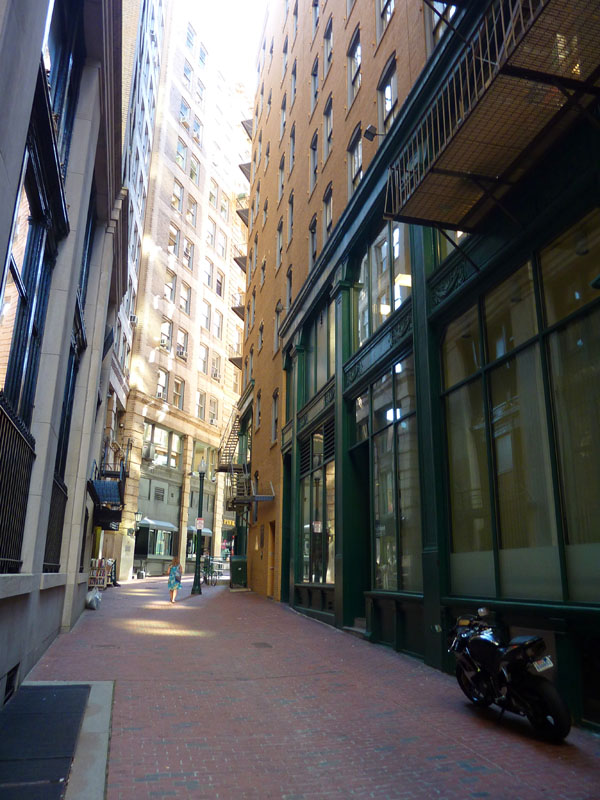
< Alley near State Street >
>>>
>>>
>>>
>>>
>>>
>>>
>>>
< Beacon Hill >
>>>
>>>
>>>
>>>
>>>
>>>
>>>
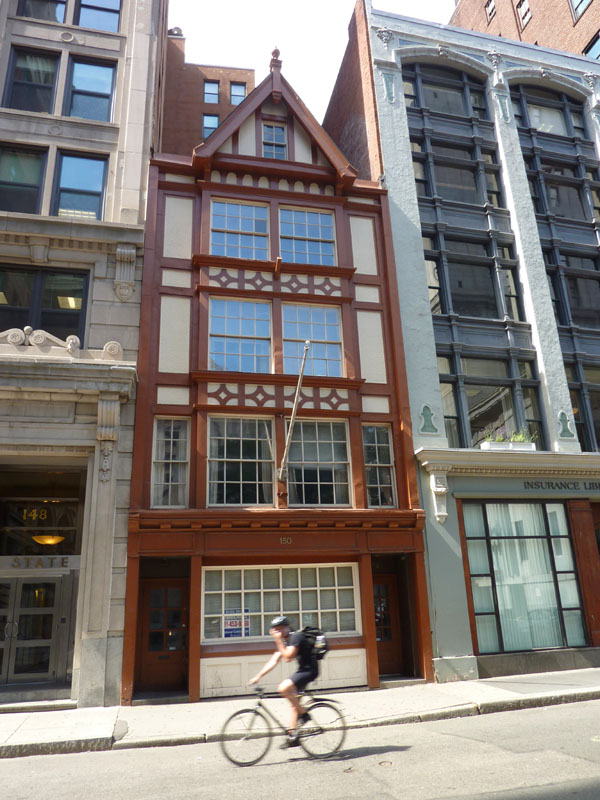
< Near Government Center >
>>>
>>>
>>>
Great places: dense, wired, and sustainable
Note: this post originally appeared on Grist, and is reprinted here with the author’s permission.

Part of what makes great places great is ecological sustainability. So what’s the best way to reduce our per-capita resource footprint? Typically you hear one of two stories. One is about technology: making gadgets, appliances, vehicles, and factories leaner and more efficient. The other is about conservation, i.e., consciously choosing to use less stuff.
Neither of those stories captures the biggest opportunity and the best strategy for reducing consumption and waste, which is, quite simply, density. Density is the sine qua non of sustainability. Generally speaking, if you’re an American living in a suburban or rural area, it doesn’t matter if you live in a green home, own a Prius, are vegetarian, have a compost bin and backyard chickens — your footprint is bigger than someone living in an efficiency apartment in Manhattan.
Why is this so? There are many reasons but the main one is simple math: living closer to other people enables you to own less and share more. You share the streets, the cars (taxis), the subways, the ports, the office buildings, the lights, the heat. Another way of putting it is, with more people closer together, a given unit of resources can go farther: a unit of space, of power, of transportation or water infrastructure. Density is inherently more efficient. (For more on this see David Owen’s Green Metropolis or this recent piece from Bryan Walsh.)
To say that density is green is not to say that all cities are green in all ways. (Obviously!) It is rather to say that when we look at pathways to radical, non-incremental change in our resource efficiency, all roads lead back to density. Nothing else has as much potential.
Consider: What’s the main barrier to sharing more stuff and owning less? Well, it’s a pain in the ass. Buying stuff is easy; indeed, the best minds in America are devoted to making it easier. But coordinating with other people to share stuff is time-consuming and often inconvenient. The main barrier to sharing is transaction costs. Density, bringing people into close physical proximity, is one way reduce those costs. Another is information technology. The two together make a modern, bright green city.
IT can do two things. One, it can make the invisible — in this case resource flows — visible. And two, it can reduce the time and labor costs of managing those flows. Here’s how I described it in a post last year:
[Efficiency] doesn’t just mean more efficient appliances and cars, but more efficient metropolitan systems. Sensors and microchips are getting cheaper so fast that pretty soon it will be possible to wire everything. Information about where energy is being generated and consumed, where traffic is congested, which parking spaces are occupied, where fresh and wastewater are flowing and how much, will be available at every node in the network. With that kind of information and the computing algorithms to make sense of it available to every building, vehicle, and consumer device, it will be possible to institute variable pricing for everything from energy to congestion to parking to water. Efficiency will be infused into the system rather than tacked on.
 Admittedly, that’s some futuristic sh*t. But the idea is to identify an end goal, so we know which direction to travel with our incremental steps. To show how it might work for transportation systems, let me quote (at some length) a review I did of a book called Reinventing the Automobile: Personal Urban Mobility for the 21st Century:
Admittedly, that’s some futuristic sh*t. But the idea is to identify an end goal, so we know which direction to travel with our incremental steps. To show how it might work for transportation systems, let me quote (at some length) a review I did of a book called Reinventing the Automobile: Personal Urban Mobility for the 21st Century:
It begins with the Urban Small Vehicle (USV), which can best be described as a computer with wheels. Because it will be electric — run, like laptop computers, on lithium ion batteries — it will be simpler and more modular than cars with internal combustion engines: “A traditional car requires elaborate systems of reservoirs, tubes, valves, and pumps to distribute the gasoline, oil, water, air, and exhaust gases, but a battery-electric automobile replaces most of these complicated distribution systems with wires connecting the batteries to the wheels.”
…
USVs will be equipped with an array of sensors and controllers that enable them to maintain steady distances from other cars, avoid crashes, and even pilot themselves. … Far more than any advanced engine or materials ever could, this situational awareness will allow the vehicles to be smaller, lighter, less armored, and more energy efficient. …
Where the vision tips over from cool-for-car-nerds into mind-blowing is not in the car itself but in how it’s connected to the power grid, other cars, and the city around it. Most cars are parked about 95 percent of the time. All those idle batteries add up to considerable energy-storage capacity. …
The authors envision USVs converging with other technologies — rooftop solar panels, small wind turbines, geothermal heat pumps, cogeneration systems, large-scale batteries, smart grids — to create a new kind of power system in which cities are generating, managing, and distributing all or most of their own electricity. …
Moreover, all USVs will be GPS- and Internet-connected. Think of the location-specific services an iPhone offers, from maps and directions to restaurant suggestions to hyper-local news. Now imagine a similar range of apps for a vehicle that’s receiving real-time information about road congestion, parking availability, and the latest box scores. Imagine the benefit to traffic planners of having information about the location and trajectory of every vehicle (encrypted, say the authors, but their discussion of privacy issues is cursory at best).
This “Mobility Internet” could lead to the same kind of innovation unleashed by the Internet itself.
What density plus IT (DIT?) can do for transportation it can also do for power. Power generated close to dense loads reduces transmission costs. It also enables the capture of waste heat, which is a big deal — see Bill McKibben’s great piece, “The Unsung Solution.” IT-infused smart grids can insure that the power produced is used more efficiently. For more on the power angle, check out a piece I wrote for Scientific American called “Local power: tapping distributed energy in 21st-century cities.” Here’s what it looks like for a Swedish neighborhood called Hammarby Sjöstad:
 < Hammarby Sjöstad’s “eco-cycle” >
< Hammarby Sjöstad’s “eco-cycle” >
Anyway, if density is at the heart of ecological sustainability, then it is at the heart of great places.
This can be somewhat uncomfortable to an older generation of environmentalists. There’s always been a strain of pastoralism in the U.S. green movement, a back-to-the-land romance that sits uneasily with the bright green focus on high-tech urbanism. Big cities were horribly dirty and unpleasant for a very long time, and that shaped generations of attitudes. It shaped a movement that came together around love of untouched wilderness and conservation of land and species.
But density is the imperative. Pastoralism is only sustainable if you cut the global population down to about a tenth its current size and/or convince hundreds of millions of people to forego the amenities of modern life. Neither of those seem likely, short of global catastrophe. More likely, the future will be crowded and resource-strained. The only way past is through, and that means putting our collective intelligence (and computing power) toward the conundrum of how to make it pleasant to live close to a bunch of other people and share a bunch of stuff with them.
On the bright side, this opens up all sorts of new routes to ecological activism. Right now the tools of activism are limited: march, picket, petition, write your congressperson, lobby, donate. It’s a narrow-band thing, a lifestyle that by nature is not going to attract all that many people.
But what if ecological activism meant figuring out how to make living together more fun? What if “going green” meant making cities more sociable, exciting, rewarding places to live? What if, instead of making people feel guilty and give up things they like, your job as as a green activist was to delight them?
That sounds like something a wider range of people could get involved in, something that would attract artists and entrepreneurs and tech geeks and forward-thinking politicians. It sounds like something suited not to a “special interest” but to a rising political generation finally ready to live in the present.
>>>
David Roberts is staff writer for Grist. You can follow his Twitter feed at twitter.com/drgrist.
Natick, Massachusetts: “Strong Town”
Vacation travels recently brought me through Natick, MA, a town of 33,000 located 15 miles east of Boston. The Boston suburbs are littered with similar small New England towns, but to me, Natick’s downtown stands out as one of the area’s best. Natick is the kind of place that advocates for “Strong Towns” drool over. Today, Natick is a highly auto-dependent town, but the solid downtown bones will help it adapt more successfully than most suburbs to the challenges of the coming decades.

< All the right stuff for a great downtown streetscape: buildings that front the sidewalk, small independent retail, ample sidewalks, varied paving, street trees, diagonal parking >

< Clark's Block, like much of the center, was built in 1874 after the "great fire," creating a unified, highly imageable downtown with a strong sense of place >

< Classic 4-story mixed-use >
Seattle as “Arrival Cityâ€: Notes Toward a Municipal Immigrant Integration Policy
“It is social diversity, not just the diversity of buildings and uses, that gives the city its soul.”
– Sharon Zukin — Naked City
>>>
The best cities are those that have the most immigrants. The source of so much of what makes our species interesting and promising, cities derive much of their scintillating creative energy and economic dynamism from their capacity to integrate and mix people who were previously distant strangers. Incubators of invention and newness, great cities perpetually throw disparate, previously un-related cultures into transfiguring collision, setting in motion evolving cultural hybrids. People from far-flung corners of the globe living in proximity, exchanging, negotiating norms and establishing new codes, cannot help but create new ideas and forms of life. As we move deeper into this difficult 21st century, we are increasingly in need of the types of new ideas that tend to come from cities. [1]
Yet if so much of what makes cities special places comes from their capacity to absorb and use the energy of those who have come from afar, why do people who love and study cities devote so little time to thinking about how urban immigrants are faring, and how we might attract more? Though some of Jane Jacobs’ most memorable passages are lush descriptions of the integral role foreign-born immigrants play in the life of the city, particularly around her beloved Hudson Street in the Greenwich Village of the 1950’s, this aspect of her writings has been largely ignored by the legions of “urbanist†writers, planners, and policy makers who have been informed and provoked by her now canonic work. [2]
Consciously or unconsciously using Jacobian language, urban planners and policy wonks love “diversity of usesâ€, and architects and engineers tout the diversity of buildings and public spaces. All these aspects of our urban built-environment and infrastructure are certainly important parts of making cities into the vibrant, bustling, noisy, provocative, weird, and sublime places they have the potential to become. But few talk about the countless advantages more foreign-born migrants would bring our city. And though it is precisely the creative concentration of international mobile labor that is largely responsible for turning “global cities†into engines of innovation, [3] foreign-born migrants rarely come up in discussions of urban economic development. This is a strange and unfortunate omission.
Richard Florida, for instance, has won wide notoriety for his argument that what makes cities successful is their capacity to attract what he calls “the creative classâ€. Knowledge workers, academics, architects, programmers, and others engaged “creative†work are now, according to Florida, the driving force in urban economies, and attracting these people should be at the center of urban economic development policy. While there is much to be said for Florida’s theories, I would argue that a city’s capacity to attract and integrate foreign-born migrants is far more important for its long-term economic strength and cultural richness than attracting the hipster website-developers Florida celebrates. And yet who, anywhere, is talking about developing strategies for attracting more foreign-born migrants to our cities?
Seattle has a proud and unique immigrant heritage, and is today home to a wonderful diversity of cultures, which are gradually making our city a more interesting and hopeful place to live. In particular the established immigrant neighborhoods throughout the I.D., C.D., South Park, Beacon Hill, Rainier Valley and High Point (and, if Seattle is lucky, perhaps soon White Center), for instance, add immeasurably to Seattle’s social capital. Any future claims we may make about being a “Global City†will be possible because we have these types of places in our urban geography. Anyone who lives or spends significant time in these and other neighborhoods throughout South Seattle, with their substantial and growing East and West African, South-East and South Asian, Latino, and Pacific Islander communities (just to name a few), might easily start to question the image of Seattle as a “white†city. [4]
Yet increasingly, Seattle is allowing our suburban regional neighbors in Tukwila, Kent, SeaTac, Burien, Redmond, and elsewhere to claim most of these new arrivals. Of course many of these recent immigrants do work in Seattle, and we as a city gain from their general economic and cultural impact on the region, so Seattle does still benefit from their contributions even though they may live elsewhere. But my point is that by not doing more proactive work to draw and integrate immigrants into our city and neighborhoods, we as a city are willfully neglecting one of our greatest advantages. And we are also depriving too many immigrants of the comparative advantage of living in the central city. As Ed Glaeser writes: “Cities are good for immigrants, and immigrants are good for citiesâ€.
There are of course many organizations throughout the city that do tremendous work on various aspects of immigrant integration. Advocacy groups like One America and Northwest Immigrant Rights Project; community-based non-profits like El Centro de la Raza, Asian Counseling and Referral Services, the Refugee Women’s Alliance, the YWCA, and Neighborhood House (disclosure: my employer); and many, many churches, schools and businesses provide crucial components of the integration process. But our city, as most cities, and indeed as our country, lacks any kind of comprehensive strategy to coordinate and support these efforts at the policy level.
In a future post I will explore in a more detailed fashion what a municipal-level immigrant-integration policy might look like. I will propose specific measures the city of Seattle could adopt to make itself a more hospitable, accessible “Arrival Cityâ€, to use the phrase coined recently by Doug Sanders in a moving and provocative book (http://arrivalcity.net/). But for now I leave with the simple hope that those who advocate for cities and those who advocate for immigrants might talk to each other more.
>>>
David Moser works for Neighborhood House, a non-profit serving Seattle’s immigrant and refugee communities (www.nhwa.org). He is also a graduate student in the Institute for Public Service at Seattle University.
[1] Edward Glaeser’s recent Triumph of the City is a definitive account of cities as “engines of innovation†that has quickly     become required reading for urban policy-makers (and has apparently become quite popular with members of the Seattle City Council http://citytank.org/2011/03/29/c200-why-cities-matter).
[2] See Roger Valdez’s “Urbanist Creed†for a good local synopsis of this world-view: http://crosscut.com/2011/02/10/urban/20603/Urbanist-creed:-What-do-we-want-for-the-places-we-live–/
[3] Much of Saskia Sassen’s work has been devoted to explaining exactly how this works.
[4] Though statistically, alas, this image is all-too-true. Amongst major U.S. cities Seattle ranks 2nd only to Portland in its percentage of Caucasian residents (about 75%). There is an honest debate to be had about how much of this imbalance is due to blatantly racist attitudes and housing covenants throughout most of the 20th century (http://depts.washington.edu/civilr/segregated.htm) and how much is due to accidents of geography (Seattle was far from the South, and thus not an easy destination for the “Great Migration†of African-Americans out of the South in the late 19th and early 20th century).
The Seattle Planning Commission On Maximizing Transit Investment

< The recently completed 351-unit "Station at Othello Park" apartments is the only new large-scale private development in any of the 5 southeast Seattle light rail station areas; photo by Dan Bertolet >
Yesterday the Seattle Planning Commission sent a letter to Seattle Department of Planning and Development Director Diane Sugimura spelling out the Commission’s recommendations for maximizing our public investment in transit. Hot and bothered yet?
Well you should be, because it’s quite the spicy letter (if you’re into that sort of thing). Read the whole thing, or if you’re more in the mood for a quickie, here are some passages that caught my eye:
- We contend that now is the time to outline a clearly defined and transparent citywide Transit Communities policy.
- We recommend transit communities receive the vast majority of new households and jobs in Seattle.
- Transit level of service should be more strongly factored into rezone criteria.
- A citywide TOD policy should model the federal approach that aligns HUD, DOT, and EPA.
- In transit communities, reevaluate single family zoned land within the five to ten minute walkshed.
- The Commission is intrigued by the concept of an iconic tower being explored in the Capitol Hill Urban Design Framework.
- The single use station proposed at Roosevelt will significantly reduce opportunities for activation, vibrancy, and ridership to support Sound Transit.
- Here in Seattle, our deep bore LINK tunnels could provide the opportunity to integrate geothermal loops into the tunnel shells, transforming our transit lines into clean energy generators and our station portals into district energy hubs for green development.
- In several Seattle neighborhoods, the elevation and alignment of the tracks (Mount Baker) or the footprint, height, and/or roof system of the station buildings (Capitol Hill, Roosevelt, Northgate) may inhibit the ability to create vibrant transit communities.
- [Parking] minimums should also be eliminated in areas with frequent transit service.
- The Planning Commission recommends establishing parking maximums and shared parking programs in transit communities.
Good on the Seattle Planning Commission for coming out of the closet on three of Seattle’s biggest taboos: single-family zoning, parking, and building height. Too bad the Commission doesn’t have more authority.
< Note: This post originally appeared on the Sightline Daily Blog. Though I’ve criticized the “gridlock” fear mongers in the past (here and here), Clark’s dissection of the data takes it to a whole new level. But don’t expect rational analysis to stop the deep-bore tunnel cheerleaders from screaming bloody gridlock until election day. —Dan Bertolet >
>>>
A few months back, the transportation consulting firm Nelson\Nygaard released a fascinating report that looked at what might happen to downtown Seattle traffic patterns if the state builds a tunnel through downtown, while imposing a steep toll on drivers who choose to take it. (We’ve already written about that report once before.)
Below, for your viewing pleasure, is the most important image from that report. Click it to see a larger version — and I’ll explain what it means in a moment.
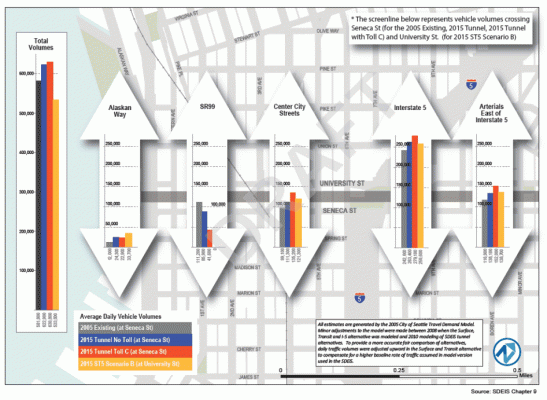
< City and state figures show that a tolled tunnel will snarl downtown traffic, compared with the "Streets, Transit, and I-5" plan >
There’s a lot of information in the chart, but you can ignore much of it. The only thing I want you to pay attention to are the orange and yellow bars:
- The dark orange bars represent the state’s projections for 2015 traffic volumes under the most likely deep bore tunnel scenario, in which drivers would pay $5.00 to use the tunnel during the afternoon rush hour.
- The yellow bars represent traffic volumes under the “ST5″ or “Streets, Transit, and I-5″ plan, using the same traffic model but with some different inputs. Under the ST5 plan, the city and state would make substantial investments in transit and “transportation demand management†to reduce traffic volumes, and also make improvements to city streets and I-5 to help improve traffic flows.
The first thing to notice is that the ST5 plan results in lower overall traffic volumes. (Those are the tallest bars to the left; the yellow ST5 bars are lower than the orange tolled tunnel ones.) If you care about greenhouse gas emissions from Seattle’s traffic, this is certainly an important thing to pay attention to.
But the second thing to notice is the length of the orange and yellow bars for center city streets, I-5, and arterials east of I-5. For all those three corridors, the orange bars are all longer than the yellow bars. And what that means is simple: the state’s own traffic models are projecting that a tolled deep-bore tunnel creates worse traffic downtown and on I-5 than the streets-and-transit plan.
It’s simply devastating news for the deep-bore tunnel, because it means that the city and state are predicting that a multi-billion dollar tolled tunnel would actually make downtown gridlock worse.
How is that even possible?
Well, the ST5 plan has several elements that encourage alternatives to cars, by investing in transit and proven transportation demand management strategies. But the tunnel has no such investments; and worse, it envisions tolls that are so steep—$9 per day for a rush-hour round trip—that the models predict that many drivers will simply avoid the tolls by taking to city streets and I-5.
This point is so damning that I’m sure that someone will claim that the numbers are being cooked. But they’re all official sources, from transportation model runs conducted or authorized by the city and state. The estimated 2015 traffic volumes for the tolled tunnel come from the state’s projections based on the Puget Sound’s transportation demand model; see exhibits 9-11, 9-12, and 9-13 in Chapter 9 of the Alaskan Way Viaduct SDEIS. The numbers for ST5 come from a different run of the exact same transportation demand model, but with a slightly different inputs. That model run was prepared for the Alaskan Way Viaduct stakeholder advisory committee, but the consulting firm Nelson\Nygaard adjusted them upwards (that is, in a direction less favorable to the ST5 plan) to make them more directly comparable to the figures from the SDEIS.
It’s also worth taking a look at Figure 4.7, which shows the projections for 2030.
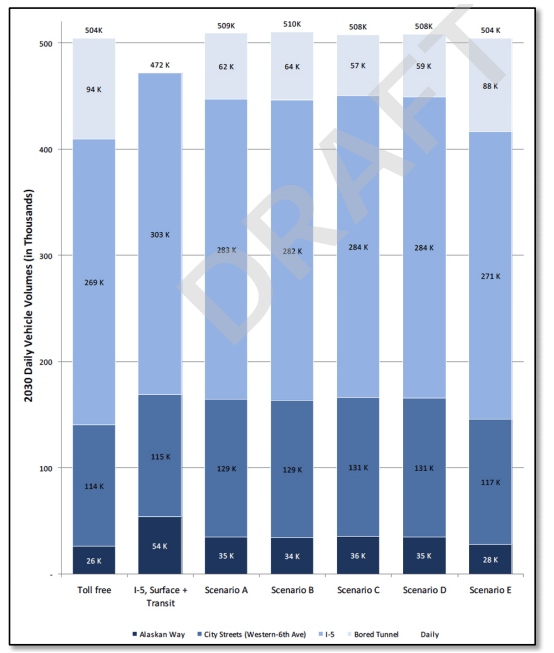
< Projections for 2030 show less traffic on city streets under the ST-5 plan >
Even in 2030, the State is projecting that downtown traffic will be worse with a tunnel than without one: 115,000 cars per day under ST5, and 131,000 cars per day under the most likely tolling system (Scenario C).
This, of course, puts a whole new spin on the ads that are running on blogs around town—suggesting if you’re “sick of gridlock†you should “move forward†by voting to build a tunnel. Perhaps the folks behind the ads should take the time to read the state’s own traffic forecasts.
>>>
Clark Williams-Derry is director of programs at the Sightline Institute
The Real Reason Cities Don’t Work For Families With Children
“Won’t somebody please think of the children?”
— The Simpsons
>>>
Nothing causes more fits of hand-wringing among urbanists than the issue of children in the city. We all want to believe that cities ought to be desirable places to live for families with children, but somehow it rarely seems to work out that way. And Seattle is quite the poster child (as it were)—although in recent years Seattle has fared better than most cities in terms of gaining households with children, of all major U.S. cities only San Francisco has a lower percentage of children.
So we fret and fuss that there aren’t enough playgrounds, or the public schools are bad, or there’s too much crime, or there are too many yuppie condos, and so on. And some or all that may be true to some degree. But there’s a much simpler reason why families with children will always be at a disadvantage in most large U.S. cities: money.
Kids cost money. There are lots of variables, but to pick a number, let’s say it costs $500 per month per kid. Two kids and that’s $1000 dollars less that’s available to spend on rent or a mortgage. If they happen to be in daycare or private school, double that. And then there’s the cost of health care insurance for children—another couple hundred per kid, or significantly more if you aren’t on a company plan. Oh, and don’t forget the college fund.
Meanwhile, families with children are competing with growing numbers of childless singles and couples for the same housing supply in the city. And on average, the childless households will win, because they have more disposable income to put towards housing.
Then add to that the fact that households with children need bigger—that is, inherently more expensive—housing to begin with.
And then add to that the fact that it’s often more of a challenge for parents to focus on their jobs, so maybe they only work part time, or their career advance is hindered, or they have to take unpaid time off when their children are sick. Which all translates to even less money to spend on housing compared to households without kids.
Based on the raw economics, we shouldn’t expect to see anything but families with children fleeing expensive cities in search of cheaper housing options at the fringe. Yes, transportation costs are likely to be higher, but historically that has not been a deciding factor for most. And besides, in Seattle and many other U.S. cities, even those who recognize the monetary value of not having to rely on a car for every trip are faced with a shortage of homes large enough for families.
In a post over at Seattle’s Land Use Code, Chad Newton notes that current for sale listings in Seattle show more than ten times as many studio, one, and two bedroom homes as three bedroom homes. For new multifamily housing, that imbalance is driven by one key factor: the smaller the unit, the higher the rent (or sale price) per square foot. It’s an easy choice for developers.
If we all agree that families with children are an important ingredient of sustainable cities, then we have to face the fact that the solution must involve, in a word, socialism. We need to compensate for the market realities of cities. And the most direct way to do that is to subsidize family-sized housing units in multifamily buildings. Like they at least tried to do in Vancouver, B.C.
The problem could also be addressed more indirectly, by reducing the cost of living through subsidies such as free day care, extended paid maternity/paternity leave, or free health care for kids. You know, like they do in the majority of developed nations worldwide.
And yes, we also need to provide amenities for children and improve the public schools. But those are moot points if parents can’t afford the housing.
>>>
A personal aside: My wife and I have two young children who attend public schools in Seattle’s Central District. We bought a neglected single-family house back in the late 1990s when the CD was still somewhat affordable, but we probably couldn’t afford our house if we had to buy it now. A couple years ago we seriously considered moving to a modest Capitol Hill condo about half the size of our house, but vetoed the idea when we considered that it would cost more than we could get for our house.
Great places: turning from stuff to happiness
Note: this post originally appeared on Grist, and is reprinted here with the author’s permission.
>>>
Today, America is making a few people rich and leaving a great many others anxious, uncertain, unhealthy, or unemployed, all while doing irreversible damage to the planet. A whole nest of challenges lies ahead: We need to radically reduce our energy use, natural resource consumption, and CO2 emissions; ramp up our innovation in clean energy and efficiency technologies; rebuild our crumbling infrastructure; restore the health of the middle class; shrink the metastasizing income gap; reform our oligarchic political institutions; reverse trends toward diabetes, obesity, and heart disease; and reconnect to each other, to mitigate the spread of depression, stress, and alienation.
That’s a handful. What ties these challenges together is the need to reorient our policies (and our myths and narratives) away from financial capital and toward social capital, so that we’re measuring success in terms of physical and mental well-being rather than GDP. It means orienting public life around happiness rather than (just) material accumulation. (Happiness isn’t the best term here, but it’s handy. More accurate would be “eudaimonia” or, as researcher Martin Seligman now prefers, “flourishing.”)
There are, of course, many Americans in poverty, suffering food or housing insecurity, and many more for whom such insecurity is one accident or health problem away. For them, getting happier and getting wealthier remain closely aligned.
But for those who have reached a basic level of material comfort, satisfied the base levels of Maslow’s hierarchy of needs, the road to happiness is not paved with more wealth. Economist Andrew Oswald wrote a great piece about this phenomenon called “The Hippies Were Right All Along about Happiness” (PDF). He cites a growing body of research showing that wealth and well-being become progressively more decoupled as wealth increases. Above a certain level, more wealth makes virtually no difference to happiness, and there’s evidence most of us in the U.S. have reached that level. Our reported levels of well-being are roughly what our grandparents’ were, while the incidence of depression and stress has actually risen and the suicide rate has stayed roughly stable.
Once we’ve secured a degree of material security, greater happiness comes not with more stuff but with social connection, a sense of personal autonomy and efficacy, the recognition/affirmation of peers, and a larger purpose beyond self-interest. For all our riches, too many Americans cannot satisfy those needs, making us, in Elizabeth Kolbert’s memorable phrase, “a nation of joyless lottery winners.”
What if we oriented public policy toward investing in and restoring our depleted social capital? In the U.S., we have been trained by decades of laissez-faire agitprop to think of government targeting happiness as vaguely Orwellian. There’s the public sphere and the private sphere; happiness lives in the private sphere, and it’s none of the government’s business.
But the fact is that every decision made in public life, from the local PTA up to the Oval Office, has some effect on our physical and social environments, and thus some effect on our well-being. If it is possible to measure such effects well and fairly (and I should emphasize that that remains to be seen), wouldn’t we be better off doing so? Why not track those effects in a transparent way so the public can assess the trade-offs they’re asked to make?
There’s lots of buzz right now around the idea of alternative indicators that incorporate well-being. Everyone cites Bhutan’s measure of “Gross National Happiness,” but fitful efforts are underway in the West as well. The U.K. Office for National Statistics started asking happiness-related questions on its surveys this year. In 2008, French president Nicholas Sarkozy created a “Commission on the Measurement of Economic Performance and Social Progress” headed by Joe Stiglitz and Amartya Sen. Their report [PDF], released in 2009, stresses well-being over GDP.
In the U.S., Gallup-Healthways has developed a “Well-Being Index” to measure America’s “mood.” Among other things, it produces a ranking of American cities by overall wellbeing. (Happiest? Boulder, Colo. Least happy? The town that coal built: Huntington, W.Va.) It also offers specific services to city and government leaders if they want targeted happiness info. As John Tierney writes in the first of two fascinating stories on the subject, Somerville, Mass., has just become the first U.S. city to put happiness-related questions on its census forms.
So things are happening! And there’s a ton of research going on around happiness right now. I won’t pretend to have consumed more than a tiny bit of it. A nice, compact introduction can be found in Nic Marks’ The Happiness Manifesto. For a longer treatment, see Martin Seligman’s new book Flourish. For article-length intros, see researcher Carol Graham and Elizabeth Kolbert. (Leave other good links in comments.)
What would public policy devoted to social capital look like? Economist Tim Jackson has some interesting thoughts along these lines:
I expect I’ll be writing more on this subject over time. For now, though, you might be wondering: What does it have to do with great places?
The answer is simple: great places help people connect socially, get more physically active, and find meaningful work. In his new book — Who’s Your City?: How the Creative Economy Is Making Where to Live the Most Important Decision of Your Life — Richard Florida discusses his massive Place and Happiness Survey, done with Gallup, which included some 27,000 people across the U.S. What it discovered is that place (where) is just important to happiness as personal relationships (who) and work (what) — and of course place is tightly interwoven with both. He says:
The place we choose to live affects every aspect of our being. It can determine the income we earn, the people we meet, the friends we make, the partners we choose, and the options available to our children and families. People are not equally happy everywhere, and some places do a better job of providing a high quality of life than others. Some places offer us more vibrant labor markets, better career prospects, higher real estate appreciation, and stronger investment and earnings opportunities. Some places offer more promising mating markets. Others are better environments for raising children.
Place also affects how happy we are in other, less palpable ways. It can be an island of stability in a sea of uncertainty and risk. Jobs end. Relationships break up. Choosing the right place can be a hedge against life’s downsides. I hate to dwell on the negative, but you need to think about this. It’s always terrible to lose a job, even worse to suffer a breakup with a significant other. As bad as those are, however, they are substantially worse if you also happen to live somewhere with few options in the job market or the mating market. It’s exponentially easier to get back on your feet when your location has a vibrant economy with lots of jobs to choose from, or a lot of eligible single people in your age range to date.
What Florida’s talking about is social capital. Great places are rich with it; living in one is like having a minimum guaranteed social income. A great place serves as a safety net, as much a form of social insurance as Social Security or Medicare.
If it’s true that our well-being is heavily influenced by the places we live — and surely it is — then public policy focused on well-being is, by nature, going to be preoccupied with great places.
>>>
David Roberts is staff writer for Grist. You can follow his Twitter feed at twitter.com/drgrist.
This is More Important: Setting the Density of Urban Centers in King County
Citytank and other Seattle blogs have lit up recently with debates over the densities at the new Link Light Rail station areas, such as in the Roosevelt neighborhood. But there’s a more important fight happening, and few people are paying attention.
For the first time in two decades, the Growth Management Planning Council of King County is set to make the first major update of the “countywide planning policies†on June 27. These policies establish the framework for all local land use and transportation plans—serving as the foundation for how we approach everything from climate change to affordable housing.
At the intersection of the entire update are the minimum standards for “urban centers.â€
With 724,000 people moving to King County in the next 30 years—a 37% increase—we need to design our cities to function much more efficiently. This means encouraging compact neighborhoods that support transit, bikes, and pedestrians and reduce the need for car trips. The result will be more vibrant and livable cities with thriving small businesses, active streetscapes, and more housing options.
Unfortunately, the staff recommendation on density for urban centers is woefully inadequate—the recommendation maintains the out-dated density of only 15 residential units per gross acre. That level of density is in the range of a typical townhouse development. Why would we set such a low target for neighborhoods like Northgate, Overlake, or South Center?

< Source: John Holtzclaw, Metropolitan Transportation Commission, “1990 Household Travel Survey†(1997) >
In 2009, Futurewise, GGLO, and Transportation Choices Coalition published the report Transit-Oriented Communities: A Blueprint for Washington State. Based on a synthesis of the best available information, the report proposed a set of recommendations for creating diverse, equitable communities in which people can meet most of their daily needs with relying on a personal automobile. And key among these was a minimum threshold for zoned capacity of 30 residential units per gross acre.
Numerous studies have documented that as densities rise from typical suburban densities towards 30 units per gross acre, the result is a significant reduction in vehicle-miles-traveled and the associated greenhouse gas emissions. One study showed that 50 units per residential acre is an approximate tipping point at which transit or walking surpass car trips (see adjacent graph, and note that a conversion from “residential acres” to gross acres would reduce the density of the mode crossover by 25% or so).
This density is not Mumbai, Beijing, or Tokyo. Three to five story buildings can easily meet this standard. Urban center neighborhoods exceeding 30 residential units per gross acre can be composed of a diverse and functional mix of single-family homes, townhouses, and taller buildings.
Furthermore, these standards would not apply to all neighborhoods in the county—just to those designated urban centers that have already signed up to accommodate future residential and job growth.
While the debates at Roosevelt and the other Light Rail station areas are important, the update to the King County countywide planning policies presents a unique opportunity to have a much bigger impact. For the next week, let’s focus on the countywide planning policies and set minimum standards for functioning cities to handle the coming 724,000 people.
After all, given it took two decades for the first major update, this could easily be the last update for the next two decades. We cannot afford to miss our chance.
H & T = Housing and Transportation = An ongoing series of intentionally banal pictures of the places in which we live with the vehicles in which we travel, pictures that have the capacity to become less and less banal the closer you look, because no matter how commonplace it all may seem to those of us who see these forms and elements every day, they are all products of diverse human personalities steeped in history and culture, and they say everything about who we really are. And as all you wonky wonks surely know, housing and transportation are the cornerstones of urban design and planning. (Click on the images to enlarge.) Last updated June 25, 2011.
>b
>b
>b
>b
>b
>b
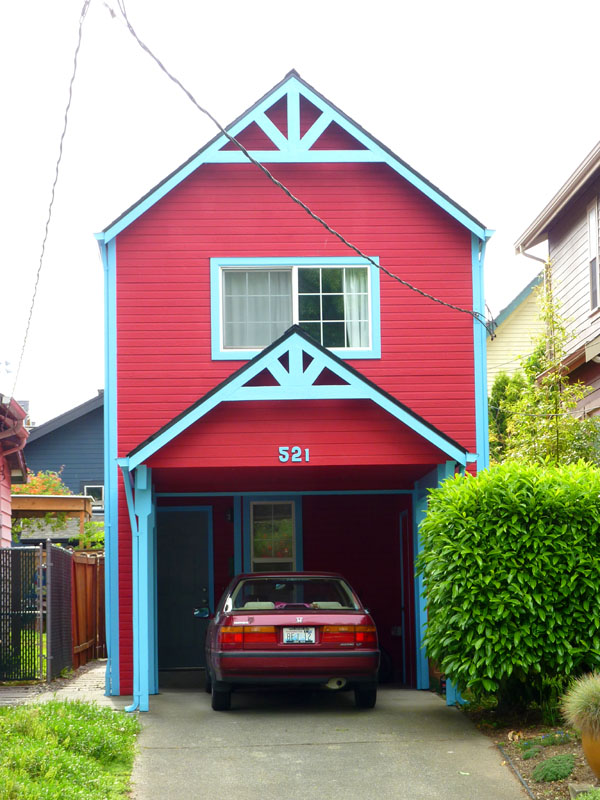
< Central District >
>b
>b
>b
>b
>b
>b
>b
>b
>b
>b
>b
>b
>b
>b
>b
>b
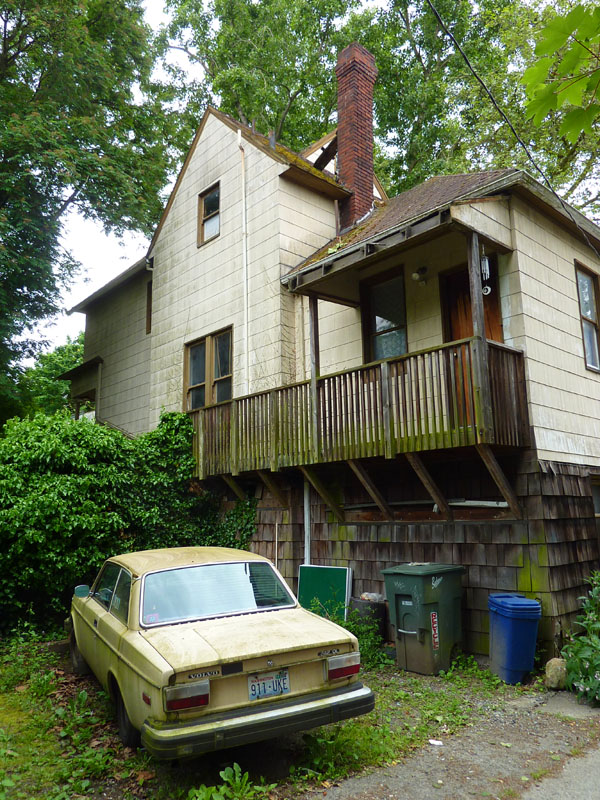
< Central District >
>b
>b
>b
More H&T photos after the jump… read more…
[Note: This post originally appeared on the Sightline blog and is part of their new series: Making Sustainability Legal.]

Source: streamishmc, flickr
What if a stupendously enormous business opportunity were hiding in plain sight before our eyes? What if this same business opportunity would bring gigantic environmental and social dividends? And what if all that was required to unleash these benefits was a simple legal reform?
Personal car sharing is such a business opportunity: a chance to trim emissions, crashes, and fuel costs, all while generating a profit for car owners and giving everyone a new way to save money. Only one legal barrier—an obscure change to insurance regulations—stands in the way.
The Pacific Northwest’s rolling stock of cars and trucks constitutes a mind-boggling amount of underutilized capital. The region has substantially more motor vehicles than licensed drivers. Everyone in the region could climb into a vehicle and no one would have to sit in the backseat. What’s more, the typical car is parked 23 hours a day. Most of us have more money tied up in our cars than in any other physical assets aside from our homes, and all that wealth is just sitting there in the driveway depreciating.
But circumstances are ripening to turn this colossal overstock into an equally massive economic and environmental opportunity.
Hard economic times, especially for the young; rising environmental concern and collaborative, nonconsumerist lifestyles; high energy prices; and the galloping spread of smart phones and social networking have given birth to a handful of start-up companies, such as Relay Rides and Getaround, intent on creating an online marketplace for private cars’ idle hours.
Such a market will give us a capitalist way to downsize our auto fleet. The profit potential is enticing. Imagine leaving town for a week and coming back to learn that your vehicle had earned you $300 on the rental market. Or imagine that your car-sharing membership gave you access, on a moment’s notice, to thousands of private cars and trucks sprinkled around your city. Why endure the expense and hassle of car ownership when you can drive any make or model you choose and only pay for what you use?
The appeal of these economics explain the rapid growth of personal car-sharing. As of May 2011, for example, car-sharing pioneer Getaround had one fifth as many cars in its network after a few months as Zipcar had in its fleet after 11 years.
Its growth may be powered by pocketbook considerations, but personal car-sharing has equally impressive nonmonetary benefits. Specifically, car-sharing shrinks our footprint. When people pay for their transportation by the trip, rather than by the vehicle, they drive less—44 percent less, on average, among car sharers studied by UC Berkeley’s Susan Shaheen. They use alternatives more. Car ownership is like an all-you-can-eat restaurant. Once you’ve paid the entrance fee, you might as well gorge. But car sharing gives us new chances to save money for each trip we don’t drive. What’s more, as car-sharing grows, it becomes an ever-more-attractive option: the more vehicles enrolled, the better car-sharing works.
Why has such a huge opportunity remained unredeemed? Insurance.
Turning your driveway into a part-time car-rental lot invalidates your auto insurance, and even if your car-sharing company brings its own insurance (they all do), the blurry line between the owner’s liability and the renter’s has been enough to hobble the nascent industry.
Fortunately, California passed a law in 2010 creating a clear division of responsibility for insurance: when any car is hired through a car-sharing company, it’s on the car-sharing insurance plan, not the owner’s. This law passed unanimously through the California legislature, which is why California is now the hotbed of personal car-sharing, with three dueling start-ups.
This month, Oregon’s legislature passed a similar bill, making the Beaver State an attractive new territory for car-sharing entrepreneurs. The bill is currently awaiting the governor’s signature. (See this blog by car-sharing pioneer Dave Brook for updates from Oregon.) Idaho, Washington, and British Columbia can welcome the car-sharing wave by quickly amending their own insurance regulations. In Washington, the legislature would also do well to exempt car-sharing from the state’s heinous and retrograde 9.7 percent car rental tax. In British Columbia, the Insurance Corporation of British Columbia and its regulators at the BC Utilities Commission can follow Oregon’s lead, combing BC’s insurance rules to allow personal carsharing. BC car-sharing pioneer, the coop Modo, is eager to launch personal car-sharing itself. It is closely watching developments in California, Oregon, and Quebec, where Communauto has launched Canada’s first personal car-sharing program, according to marketing director Bernice Paul.
Allowing an hourly market for off-duty cars could make a big contribution to creating healthy, lasting prosperity. It’d give more people ready access to a car without having to buy one (or a second one). It would shrink the over-capacity in the vehicle fleet and drive steep reductions in how much driving we do—in ways that generate profits (or savings) for both car owners and nonowners. Along the way, it would help stabilize the climate by preventing greenhouse gas emissions, help reduce traffic congestion by tamping down discretionary trips, help liberate parking spaces for other uses, help create jobs by keeping dollar circulating locally (rather than leaving the region to buy vehicles and fuel), help save lives (by reducing car wrecks and, perhaps, obviating oil wars), and help make us all fitter and trimmer (by spurring us to walk more).
All that’s required is that we fix some insurance rules.
>>>
Alan Durning is executive director of the Sightline Institute.
The Low-Hanging Fruit Of Public Urban Eco-Services
Electric cars and charging stations have arrived, bringing with them the opportunity to reduce commuters’ carbon footprint. Nowhere is this more true than in dense urban areas.
Even if you travel by single occupancy vehicle (as opposed to transit or bicycle) living in the dense, compact-development context of multifamily housing can bring your carbon footprint down way below the national average. It is well-known that folks who live in vertical neighborhoods are far more likely to find what they need (and head out to earn their living) via much shorter trips than their single-family dwelling counterparts.
So I find it surprising how little discussion there has been about the apartment and condo context for electric vehicle owners. And that’s why I was glad to see this Transportation Nation blog post recently, featuring a condo dweller who was among the first in the nation to own the new Chevy Volt. His challenge (working with his HOA to retrofit their parking area) will hopefully be resolved; the solution celebrated and replicated.
For while there’s simply no match for a city networked with robust, convenient and pleasant public transit, walking and biking routes, rethinking a car-oriented city takes time. While we wait, making it easy for individuals to lighten the impact of their single-occupancy vehicle, especially when they’re already urban, ready and willing to pay that premium for eco-piety, behooves us all.
Here in the Puget Sound, in particular, since our grid is fed largely by lower-impact hydropower, getting urbanites off oil and onto the grid, can be low-hanging fruit.
Speaking of fruit, how many multifamily buildings have food waste pickup at this point?
>>>
Nate Cole-Daum is a board member of Great City.
Great places: reorienting progressive politics for the 21st century
[Note: this post originally appeared on Grist, and is reprinted here with the author’s permission.]
>>>
I asked a while back what new vision or principles could unite the left’s fractious coalition. As you probably guessed, I’ve got a pet idea along these lines. It’s a bit out in left field, at least in terms of mainstream political discussion, but I’m fond of it.
The bumper sticker version is: great places. Making the places we live and work more resilient, intelligent, productive, and pleasant. Making places that encourage good physical and mental health. Making places with a sense of common purpose, identity, and pride. Making great places.
An agenda (loosely) based on making great places is attractive for a number of reasons, which I’ll explore in future posts. But one of my favorite things about it is that it cuts across the decrepit political arguments that dominate U.S. politics: small or big government, capitalism or socialism, growth or sustainability.
When Obama was campaigning, he said he wanted to get past the “stale debates” that have clung to American politics like a bad hangover since the 1960s. We were told it was the first election of a new generation. It turns out, though, there’s a large cadre of angry older white men who don’t want to let those debates go. So the media-political complex in America, still largely dominated by older white men, dwells endlessly on a parade of coded resentments like death panels and rappers visiting the White House.
But the rest of us don’t have to play along! We don’t have to take part in these Groundhog Day debates. Believe me, I’m not talking about being a “moderate” or a “centrist” — a position in between two poles of a dumb debate is still dumb. I’m talking about striving to see things with fresh eyes, to think anew about the unique challenges and opportunities of our historical moment. We’re in a time of profound, rapid change and we need an agenda that looks to the future with purpose and confidence.
I doubt the groping around I’m going to do in the next few posts merits that grandiose description, but I do think that a focus on place has at least some potential to reorient politics and bring together several traditionally siloed interest groups and value sets. Over at the Project for Public Spaces, Ethan Kent is thinking along similar lines in a post called “Placemaking as a New Environmentalism,” but while I agree with most of what he says, I think he goes badly wrong in framing this as an extension of environmentalism, which is a specific social movement with is its own set of concerns and political tools. Focused attention to place is something different. It doesn’t need the baggage of any -ism. Resource sustainability is part of it, but so are economic and social sustainability.
Another inspiration for my thinking came from my hometown alt weekly, The Stranger, in its epic post-2004 election piece called “The Urban Archipelago.” It’s written in The Stranger‘s inimitable style, which will sound coarse, partisan, and aggressive to some ears, but it gets at blunt truths:
If Democrats and urban residents want to combat the rising tide of red that threatens to swamp and ruin this country, we need a new identity politics, an urban identity politics, one that argues for the cities, uses a rhetoric of urban values, and creates a tribal identity for liberals that’s as powerful and attractive as the tribal identity Republicans have created for their constituents. John Kerry won among the highly educated, Jews, young people, gays and lesbians, and non-whites. What do all these groups have in common? They choose to live in cities. An overwhelming majority of the American population chooses to live in cities. And John Kerry won every city with a population above 500,000. He took half the cities with populations between 50,000 and 500,000. The future success of liberalism is tied to winning the cities. …
For Democrats, it’s the cities, stupid — not the rural areas, not the prickly, hateful “heartland,” but the sane, sensible cities — including the cities trapped in the heartland. Pandering to rural voters is a waste of time. Again, look at the [electoral] map. Look at the urban blue spots in red states like Iowa, Colorado, and New Mexico — there’s almost as much blue in those states as there is in Washington, Oregon, and California. And the challenge for the Democrats is not just to organize in the blue areas but to grow them. And to do that, Democrats need to pursue policies that encourage urban growth (mass transit, affordable housing, city services), and Democrats need to openly and aggressively champion urban values. By focusing on the cities the Dems can create a tribal identity to combat the white, Christian, rural, and suburban identity that the Republicans have cornered. And it’s sitting right there, on every electoral map, staring them in the face: The cities.
This is what I was trying to get at in my earlier post: If the right has cornered the white rural/suburban demographic, the left needs to gather everyone else and give them an identity of their own.
I’m going with “great places” rather than “cities” because, while there’s no doubt that density is the bedrock principle here (more on that later), the city will not always be the relevant level of analysis. There can be great places inside cities (neighborhoods) and great places that bind several cities together (metropolitan areas). And yes, even smaller cities and towns can be great places (more on that later too). Everyone is of a place.
No matter what term is used, the whole notion will be attacked as elitist, of course. It always is. Many people who live in dense, walkable areas tend to pigeonhole urbanism as elitism. It brings to mind … well, Portlandia. This is obviously a PR challenge, but it’s worth noting that on the merits it’s completely wrong. Families benefit from walkable density too. Kids who walk and bike to school are healthier, and so are their parents. Old people benefit from ready access to services. And everyone — every human being, by dint of simple biology — benefits from more human contact and social connection. Even conservatives are nostalgic for small-town life, though they don’t seem to realize that it was the human scale that made small towns so pleasant. Go to almost any town or city in the country these days and you’ll find people trying to restore walkable downtown districts, add green space and trails, and attract creative young people. No matter our age or political affiliation, all of us would rather live in great places.
So anyway, that’s enough hemming and hawing by way of introduction. In subsequent posts I’ll explore various facets of this idea. I’m going to be racing past a lot of complicated subject matters about which I’m no expert (viva blogging!), so it would be great to hear from folks who know more than I do. Lots of people have been thinking about and working on various aspects of place for a long time; hopefully I can weave some threads together in a way that does them minimal violence.
>>>
David Roberts is staff writer for Grist. You can follow his Twitter feed at twitter.com/drgrist.
A big part of my obsession with Lewis Mumford is fueled by his extraordinary prescience. In a review of a recent University of Toronto study on the induced demand effect of road building, the Infrastructurist’s Eric Jaffe reveals yet another Mumford gem dating from 1955:
[O]ur one-eyed specialists continue to concoct grandiose plans for highway development, as if motor transportation existed in a social vacuum. … Instead of curing congestion, they widen chaos. …
All the current plans for dealing with congestion are based on the assumption that it is a matter of highway engineering, not of comprehensive city and regional planning, and that the private motorcar has priority over every other means of transportation, no matter how expensive it is in comparison with public transportation, or how devastating its by-products.
More than half a century later, we’re still battling this mindset. The root problem is it’s simply easier to build another road, ignore the evidence all around us, and blindly hope that this time it will magically make it all better.
In contrast, “comprehensive city and regional planning” takes innovative thinking, complex cooperation, and most importantly, a holistic, long-term perspective. And because we have not risen to that challenge, we have gotten what we deserved—a tragically imbalanced, unsustainable transportation system ill-suited for the demands of the coming century.
And while we’re on the topic of his uncanny crystal ball, here’s Mumford laying out the case for smart growth in The City in History, published in 1961:
By building up sub-centers, based on pedestrian circulation, within the metropolitan region, a good part of urban transportation difficulties could have been obviated. To make the necessary journeys about the metropolis swift and efficient the number of unnecessary journeys—and the amount of their unnecessary length—must be decreased. Only by bringing work and home closer together can this be achieved.
I hesitate to drag Citytank down to this level, but since I was called out by name, I can’t resist noting the comment made about me by the Seattle Displacement Coalition’s John Fox and Carolee Colter in a recent Capitol Hill Times editorial.
Under a heading entitled A message of arrogance, they cite the following from a recent blog post of mine as an example of “disturbing arrogance:”
Decisions of regional consequence should not be left entirely up to local residents…. Seattle’s leaders have an obligation to make sure land-use decisions benefit not just the neighborhood but also the greater region and…the entire planet.
Got that? If your concerns extend beyond the boundaries of a local neighborhood, you are arrogant. Might I suggest, Mr. Fox and Ms. Colter, that next time you work with an editor. Unless, that is, you both truly do believe that every neighborhood is an island and people have no business getting involved in regional or global issues.
P.S. I’ve had some fun with Mr. Fox in the past (here, here, and here), so I guess it’s only fair that he finally hit me back with a real zinger.

